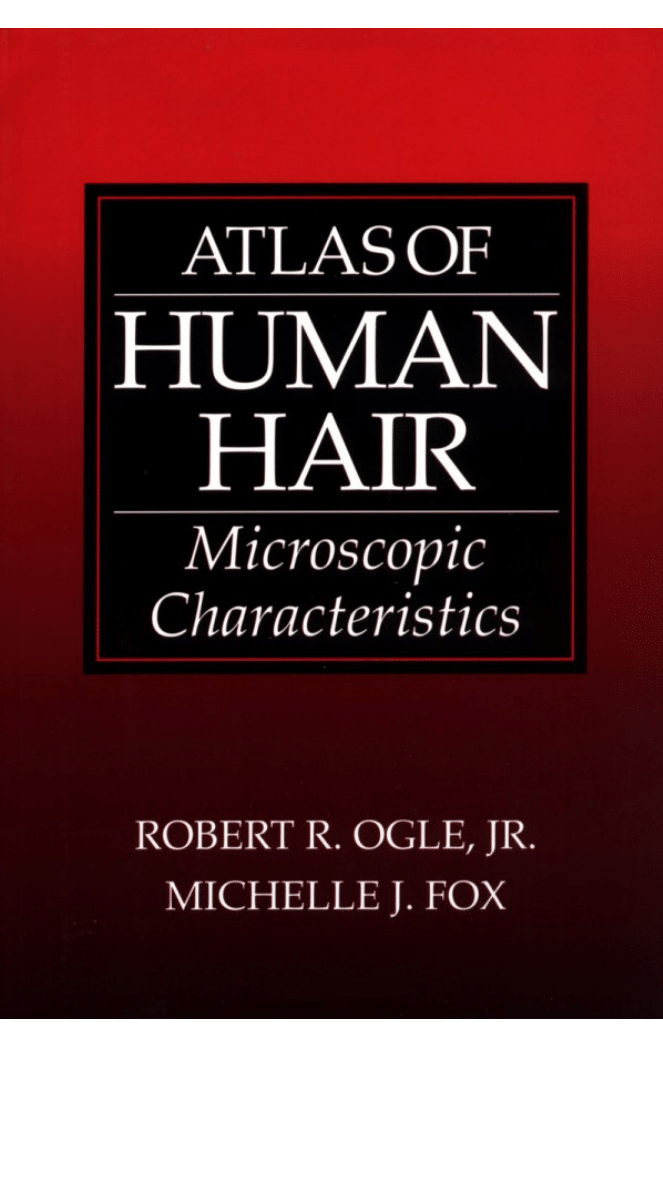

©1999 CRC Press LLC
Atlas of Human Hair
Microscopic
Characteristics
Robert R. Ogle, Jr.
Forensic Scientist
Vallejo, CA
Michelle J. Fox
Forensic Scientist
Forensic Analytical Specialties
Hayward, CA

Acquiring Editor:
Becky McEldowney
Project Editor:
Michelle Davidson
Marketing Manager:
Arline Massey
Cover design:
Jonathan Pennell
Library of Congress Cataloging-in-Publication Data
Ogle, Robert R.
Atlas of human hair microscopic characteristics / Robert R. Ogle,
Michelle J. Fox
p. cm.
Includes bibliographical references and index.
ISBN 0-8493-8134-7 (alk. paper)
1. Hair—Analysis—Atlases. 2. Forensic dermatology—Atlases.
I. Fox, Michelle J.
II. Title.
RA1061.037 1998
614' .05—dc21
98-34752
CIP
This book contains information obtained from authentic and highly regarded sources. Reprinted
material is quoted with permission, and sources are indicated. A wide variety of references are listed.
Reasonable efforts have been made to publish reliable data and information, but the author and the
publisher cannot assume responsibility for the validity of all materials or for the consequences of their use.
Neither this book nor any part may be reproduced or transmitted in any form or by any means,
electronic or mechanical, including photocopying, microfilming, and recording, or by any information
storage or retrieval system, without prior permission in writing from the publisher.
The consent of CRC Press LLC does not extend to copying for general distribution, for promotion,
for creating new works, or for resale. Specific permission must be obtained in writing from CRC Press
LLC for such copying.
Direct all inquiries to CRC Press LLC, 2000 Corporate Blvd., N.W., Boca Raton, Florida 33431.
Trademark Notice:
Product or corporate names may be trademarks or registered trademarks, and are
only used for identification and explanation, without intent to infringe.
© 1999 by CRC Press LLC
No claim to original U.S. Government works
International Standard Book Number 0-8493-8134-7
Library of Congress Card Number 98-34752
Printed in the United States of America 1 2 3 4 5 6 7 8 9 0
Printed on acid-free paper
©1999 CRC Press LLC

©1999 CRC Press LLC
Preface
Two problems have confronted researchers and examiners in the forensic
examination, comparison, and identification of human hair. First, the ability
to describe the microscopic characteristics of hair in a uniform manner
among workers in different geographical areas has been frustrated owing to
the lack of an atlas that all workers could reference when describing a par-
ticular characteristic or one of its variates. Second, the ability of the researcher
to develop frequency data for the variates of each characteristic has been
hindered owing to the lack of a uniform reference for identifying the specific
variate of a microscopic characteristic seen in a study hair. This atlas will
remedy those two problems by providing photographic archetypes for human
hair microscopic variates that will both provide a vehicle for uniformity in
the descriptors for these variates and the partitioning of the microscopic
characteristics into variate classes for determination of frequency data for
each of the variates in a study population.
The hair atlas also introduces a systematic scoring system that permits
the researcher or examiner to easily and rapidly score the variates seen in a
study hair. This scoring system will facilitate the development of frequency
data for each of the microscopic characteristic variates and for the hair type
represented by the specific combination of the characteristic variates found
in a study hair.
Although the primary aim of the atlas is to contribute archetypes for the
microscopic characteristics of human hair, certain of the macroscopic char-
acteristics are included because those characteristics and their variates are
integral to the concept of the hair type. A novel template is provided so that
measurement of the hair shaft curvature can be accomplished quickly and
scored rapidly.
Chapter 1 introduces the concepts of forensic hair examination necessary
for proper use of the atlas. A discussion of the terminology used in the atlas
follows, and a brief discussion of the concepts underlying the individualiza-
tion of physical evidence is provided. The numerical scoring system for
describing the microscopic variates is explained so that the user will know
how the scoring system operates when examining a study hair. A brief

©1999 CRC Press LLC
discussion of the materials and methods used in producing the atlas is pro-
vided at the end of the chapter.
Chapter 2 introduces those macroscopic characteristics necessary for
identifying the hair type of a study hair and furnishes the template for hair
curvature measurement. Those macroscopic characteristics that contribute
to the concept of the hair type are the hair form (type of curl), degree of hair
curl, and shaft length. These macroscopic characteristics and certain of the
microscopic characteristics combine to determine the hair type, as discussed
in Chapter 6.
Chapter 3 provides a discussion of each microscopic characteristic and
its variates. The microscopic characteristic variates are presented photo-
graphically in Chapter 5.
Chapter 4 considers cross-sections of the hair with regard to a number
of microscopic characteristics. Photographic archetypes for the variates of
the cross-section characteristics are presented in Chapter 5.
Chapter 5 demonstrates the microscopic characteristic variates with color
photographic archetypes and line drawings for those characteristics for which
no photographs were available.
Chapter 6 introduces the concept of the genetically produced hair type
and presents data regarding the geographic region heritage hair types for
both scalp and pubic hair.
A glossary of certain terms used in the atlas also is enclosed for the
convenience of the reader, and there is an extensive bibliography of publica-
tions pertaining to forensic hair examination for the convenience of the
reader. The bibliography will provide a starting point for literature searches
for the novice hair examiner and a ready reference for the researcher in
forensic hair examination, comparison, and identification.

©1999 CRC Press LLC
Acknowledgments
The authors gratefully acknowledge the generous donation of time and hair
characteristic specimens loaned to them by James G. Bailey, criminalist with
the Los Angeles Sheriff ’s Department Forensic Laboratory and a widely noted
authority in forensic hair examination. It is unlikely that this atlas would
have been completed in a timely manner without his loan of specimens and
his helpful comments during the preparation of the manuscript.
A special thanks is due to David Kahane and Forensic Analytical of
Hayward, CA, for funding the photography for the atlas. Thanks are also due
to Larry Wayne, research assistant to Michelle Fox, for his help in preparing
the many photographic specimens necessary for the completion of the atlas,
and to Nicholas Petraco and Richard Bisbing for their input regarding the
content of the atlas.

©1999 CRC Press LLC
The Authors
Robert R. Ogle, Jr.
is a forensic scientist retired from active consulting. He
remains active in research and is an author and publisher in the field of
forensic science. He received his undergraduate degree in Letters and Science
(Zoology) from the University of California at Berkeley. He is a past president
of the California Association of Criminalists. He is the author of
Crime Scene
Investigation and Physical Evidence Manual
, a widely accepted textbook in
crime scene investigation. Mr. Ogle has presented papers on human hair
individualization at forensic science meetings and has published in the area
of human hair forensic examination in the
Journal of Forensic Sciences
. Mr.
Ogle began his career in criminalistics with the Contra Costa County, Cali-
fornia Office of the Sheriff–Coroner and later managed forensic laboratories
for the California Department of Justice. He has been an independent con-
sultant in forensic science for the past 20 years.
Michelle J. Fox
is a forensic scientist at Forensic Analytical in Hayward, CA.
She has presented expert testimony in the areas of firearms evidence, gunshot
residue analysis, and forensic hair examination. She received her bachelor of
arts degree in forensic science from Michigan State University and her Mas-
ters of Public Health degree in the area of forensic science from the University
of California at Berkeley. She maintains memberships in both the California
Association of Criminalists and the American Academy of Forensic Sciences.
Her research interests include firearms evidence and forensic hair examina-
tion. She has received specialized training in the areas of firearms and tool-
mark examinations, crime scene investigation and reconstruction,
examination and identification of human and animal hair, and trace evidence
examination. Ms. Fox has presented papers at scientific meetings on the
examination of trace evidence and toolmarks.

©1999 CRC Press LLC
Table of Contents
Preface
Acknowledgments
The Authors
1 Introduction to the Atlas of Human
Hair Microscopic Characteristics
1.1 Scope and Function of the Atlas
1.2 Terminology
1.3 Individualization of Physical Evidence
1.4 Numerical Scoring of Hairs
1.5 Materials and Methods
2
Human Hair Macroscopic Characteristics
2.1 Hair Form
2.2 Degree of Hair Curl
2.3 Shaft Length
3
Human Hair Microscopic Characteristics
3.1 Color
3.2 Pigment Density
3.3 Pigment Granule Size
3.4 Pigment Distribution
3.5 Pigment Aggregate Shape
3.6 Pigment Aggregate Size
3.7 Medulla Continuity
3.8 Medulla Opacity
3.9 Cuticle Thickness
3.10 Inner Cuticle Margin
3.11 Outer Cuticle Scale Profile
3.12 Cuticle Surface

©1999 CRC Press LLC
3.13 Pigment In Cuticle
3.14 Cortical Texture
3.15 Cortical Fusi
3.16 Ovoid Bodies
3.17 Root Growth Stage
3.18 Distal Tip Characteristics
3.19 Maximum Shaft Diameter
3.20 Shaft Aberration
3.21 Hair Treatments
3.22 Hair Diseases and Disorders
3.23 Miscellaneous Characteristics
3.24 Insect, Arachnid, and Fungal Presence and Damage
4
Human Hair Cross-Section
Characteristic Variates
4.1 Shaft Cross-Section Shape
4.2 Cross-Section Cuticle Thickness
4.3 Cross-Section Pigment Density
4.4 Cross-Section Pigment Granule Size
4.5 Cross-Section Pigment Distribution
4.6 Cross-Section Cortical Texture
5
Human Hair Microscopic Characteristics:
Photographs and Drawings of Variate
Archetypes and Examples
5.1 Color
5.2 Pigment Density
5.3 Pigment Granule Size
5.4 Pigment Distribution
5.5 Pigment Aggregate Shape
5.6 Pigment Aggregate Size
5.7 Medulla Continuity
5.8 Medulla Opacity
5.9 Cuticle Thickness
5.10 Inner Cuticle Margin
5.11 Outer Cuticle Scale Profile
5.12 Cuticle Surface
5.13 Pigment in Cuticle
5.14 Cortical Texture

©1999 CRC Press LLC
5.15 Cortical Fusi
5.16 Ovoid Bodies
5.17 Root Growth Stage
5.18 Distal Tip Characteristics
5.19 Shaft Aberration
5.20 Hair Treatments
5.21 Hair Diseases and Disorders
5.22 Miscellaneous Characteristics
5.23 Insect, Arachnid, and Fungal Presence and Damage
5.24 Cross-Sectional Shape
5.25 Cross-Sectional Pigment Distribution
6
Human Hair Types
6.1 The Human Hair Type
6.2 Regional Human Hair Characteristic Variates
6.3 Regional Pubic Hair Characteristics
References
Glossary
Bibliography

©1999 CRC Press LLC
Introduction to the
Atlas of Human Hair
Microscopic
Characteristics
1.1 Scope and Function of the Atlas
The atlas was designed to provide photographic examples of the features
of human hair seen through the compound microscope which are used by
forensic hair examiners in the examination, comparison, and identification
of human hairs. Two purposes are served. The photographic illustrations
are intended to provide the trainee in forensic hair comparison with a
comprehensive set of examples of those characteristics which need to be
considered when making a comparison between an evidence hair and exem-
plar hairs from an individual. In addition, the illustrations will provide a
uniform basis for describing the characteristics and their variations by
researchers and examiners in differing geographical areas. The documen-
tation of hair characteristics using the scoring system outlined in this atlas
will allow researchers and examiners to develop data regarding the fre-
quency of characteristics within the hairs of one or more individuals and
the assessment of whether certain hair characteristics are co-dependent.
Where for various reasons photographs were not available for inclusion in
the atlas, line drawings are presented to illustrate the characteristics
described in the tables and in the text.
Although the focus of this atlas is on the microscopic characteristics of
human hair, a number of macroscopic characteristics are presented in Chap-
ter 2. The macroscopic characteristics are presented because they are an
integral component of the examination and comparison process for hairs.
1

©1999 CRC Press LLC
A glossary of terms used in the atlas is presented in Appendix I. In
addition, an extensive bibliography of articles pertaining to forensic hair
examination is presented in Appendix II.
This atlas is intended for use by the experienced forensic hair examiner
as an aid in research or as a tool in the training of other examiners. This
book does not include a discussion of methods and procedures for human
hair analysis, nor does it present a protocol for the interpretation of results
from human hair comparisons. For a protocol on the examination of hair
evidence, see Shaffer.
1
1.2 Terminology
In the case of human hair, the characteristics which form the basis for hair
comparison and identification are well known and are described throughout
the literature on forensic hair examination. Although a number of terms have
been used to describe the characteristics of human hair (e.g., “characteristic,”
“feature,” “attribute,” etc.), the terminology throughout this atlas is confined
to the term “characteristic” as the general feature descriptor. Examples of
“characteristics” include, but are not limited to, curl, color, pigment distri-
bution, pigment density, cortical fusi, and ovoid bodies. The macroscopic
characteristics for human hair are listed in Chapter 2, and the microscopic
characteristics are listed in Chapter 3.
The term “variate” is used as the descriptor for the various forms of each
macroscopic or microscopic characteristic seen in human hair. For example,
the various forms of the characteristic Pigment Distribution are described
by the variate terms Uniform, Peripheral, One-sided, Central, and Random.
The variates for each characteristic are listed in Chapters 2 and 3.
The term “photographic archetype” refers to the photographs presented
throughout this atlas to demonstrate the characteristic variates. An archetype
is a model adopted for the specific purpose of establishing a standard of
comparison.
Most hair characteristics have continuous variation over the entire range
of variation exhibited. Continuous variation means that the difference
between one variate and its closest neighbor in terms of similarity is virtually
indiscernible. For example, the range of variation for all brown hairs is
continuous, where one shade of brown may be indistinguishable from the
next closest shade of brown. This assumption that continuous variation exists
is due to the large number of hairs on a single scalp and the large number
of humans in the world population. This issue of continuous variation within
a hair characteristic requires that the variation be partitioned into a number
of variate classes. This division into two or more variate classes requires the

©1999 CRC Press LLC
adoption of photographic archetypes to define the “variate class limits,” or
the upper and lower limits of the range of variation for a single variate. For
those characteristics having continuous variation, each of the characteristic
variate class limits is defined by photographic archetypes. Some hair charac-
teristic variates are determined by measurement (e.g., Maximum Shaft Diam-
eter). For those characteristic variates determined by measurement, no
photographic archetypes are presented.
Some of the hair characteristics demonstrate discontinuous variation.
Discontinuous variation means that each variate of a characteristic has a
recognizable form which is different from the other variates. For example,
the characteristic Pigment in Cuticle can be exhibited by the discontinuous
variates Present and Absent. For those characteristics with discontinuous
variates, the photographic archetypes represent examples of each variate.
The term “class characteristic” refers to a characteristic shared by all
members of a class. A class of objects can be defined by a single characteristic
or by a combination of characteristics shared by the members of the class.
Except in rare circumstances, a class is defined by a combination of these
class characteristics (e.g., 38 caliber firearms having rifling with six lands and
grooves with a left hand twist, blond human hair, etc.).
The term “individual characteristic” refers to a characteristic that is
unique to a single object in a class, or to a class characteristic that
varies
in
some way from one member of the class to another. This variation in the
class characteristic can be combined with other class characteristics which
also exhibit variation, so that the
specific combination of these characteris-
tics’ variations
may be unique within the class of objects. For example, fired
bullets have a class of characteristics called “striations,” which are the result
of the bullet being marked by the interior surface of the barrel as the bullet
passes through the barrel. Although a single striation on the bullet cannot
be determined to be unique to that barrel, the
combination
of the
occurrence
and spatial relationships
of a number of striations can be determined to be
unique to that specific barrel. Thus, the striations are considered to be indi-
vidual characteristics, since their combination as a set allows for individual-
ization of the fired bullet.
The specific
combination
of genetically controlled macroscopic and
microscopic characteristic variates observed in a particular hair is termed in
this atlas as the “
hair type
.” The determination of hair type will allow
researchers to develop data to determine the frequency of a hair type within
an individual or within a group of individuals. Hair type data may also
provide information on whether certain characteristics are co-dependent.
The macroscopic and microscopic characteristics used to define the hair type
are listed in Chapter 6.

©1999 CRC Press LLC
1.3 Individualization of Physical Evidence
The central concept in the forensic science specialty called criminalistics is
individualization. Individualization is the cement that binds together all the
disciplines in the forensic sciences involving the examination of physical
evidence with the aim of identifying the source of an evidence item. That
concept applies equally to a fired bullet, a signature on a document, a hair
or fiber found on a murder victim, or a bloodstain found at a crime scene.
Each discipline may use different techniques to individualize its particular
type of physical evidence, but the approach to the individualization process
is the same. The concept of individualization requires that a questioned item
(an item with a questioned source) must have a combination of class and
individual characteristics which agrees with that combination in an item of
known source. Some types of physical evidence may be individualized (e.g.,
fingerprints, fired bullets), while others may be identified only as to the class
to which the evidence belongs (e.g., hairs, fibers, glass).
The individualization process is a two-step operation, where the ques-
tioned item is first compared to an item of known source to determine if the
class characteristics are the same.
2
If they are different, the known source is
excluded as a possible source of the questioned item. If the class character-
istics are the same, the individual characteristics are then compared. If the
individual characteristics are not the same, then the examiner must deter-
mine whether the degree of difference observed is equivalent to or exceeds
the degree of difference observed when comparisons are made between
experimental specimens and known nonsources for the specimens within the
same class. If the degree of difference observed exceeds the degree of differ-
ence noted in comparisons between experimental specimens and known
nonsources, then the known sample may be excluded as a source for the
questioned item. If the difference observed does not meet the established
criteria for exclusion based on these comparisons between experimental spec-
imens and known nonsources for the specimen, then the known source
cannot be excluded as a source for the questioned item. If the individual
characteristics are the same, then the known source may be identified as the
source of the questioned item where the set of class and individual charac-
teristics, which is the basis for the agreement between the questioned item
and known sample, can be shown to be unique within the class. An identi-
fication of a known source based on the combination of class and individual
characteristics shared between the questioned item and the known item is
based on the concept that a
set
(i.e., the combination) of class and individual
characteristics can be unique to a single object when compared to the entire
class of similar objects.

©1999 CRC Press LLC
For most types of physical evidence, the assessment of uniqueness of the
set of class and individual characteristics which is the same for the questioned
and known is accomplished by the examiner through reference to either a
database of the frequency of the components of the pattern (as in the assess-
ment of a blood sample’s DNA pattern) or by reference to the examiner’s
experiential database in examining that particular type of physical evidence,
as in fingerprints, firearms, questioned writings, etc.
3
The examiner’s expe-
riential database is augmented by the study of the literature regarding the
individualization of each type of physical evidence and the published expe-
riences of other workers in the same discipline during the examiner’s training
period. In the microscopic examination of human hair, individualization is
rarely possible due to the lack of a reference database for the assessment of
uniqueness of the set of characteristic variates (the hair type) for a given hair.
1.4 Numerical Scoring of Hairs
Although the macroscopic and microscopic characteristic variates used by the
forensic examiner in the comparison of hairs can be used to distinguish
between hairs from different individuals, there has been no systematic attempt
to develop data on the frequency of those characteristic variates in study pop-
ulations. One of the primary purposes of this atlas is to present photographic
archetypes which will provide a uniform basis for the generation of data on
study populations, so that data from different researchers or examiners can be
combined to form a larger database of characteristic variate frequencies.
An innovation of the atlas is the introduction of a numerical scoring
system permitting the hair type to be presented as an array of alphanumerical
scores. Use of the scoring system will simplify the task of developing fre-
quency data for macroscopic and microscopic characteristics and for the hair
types found in a study population. The frequency data developed from the
studies will enhance the ability of the forensic hair examiner to evaluate the
determination that a questioned hair is similar to known hairs from an
individual, both in the examiner’s report and in the examiner’s testimony in
judicial proceedings.
The numerical scoring system is based on photographic archetypes which
define the class limits of characteristic variates. The scoring system allows
the examiner to express hair type as an array (ordered series) of double-digit
numbers with each double-digit number preceded by a letter identifier. The
generation of frequency data can thus be accomplished through the use of
simple computer programs and will allow researchers to assess the rarity of
a particular variate or hair type in the study population.
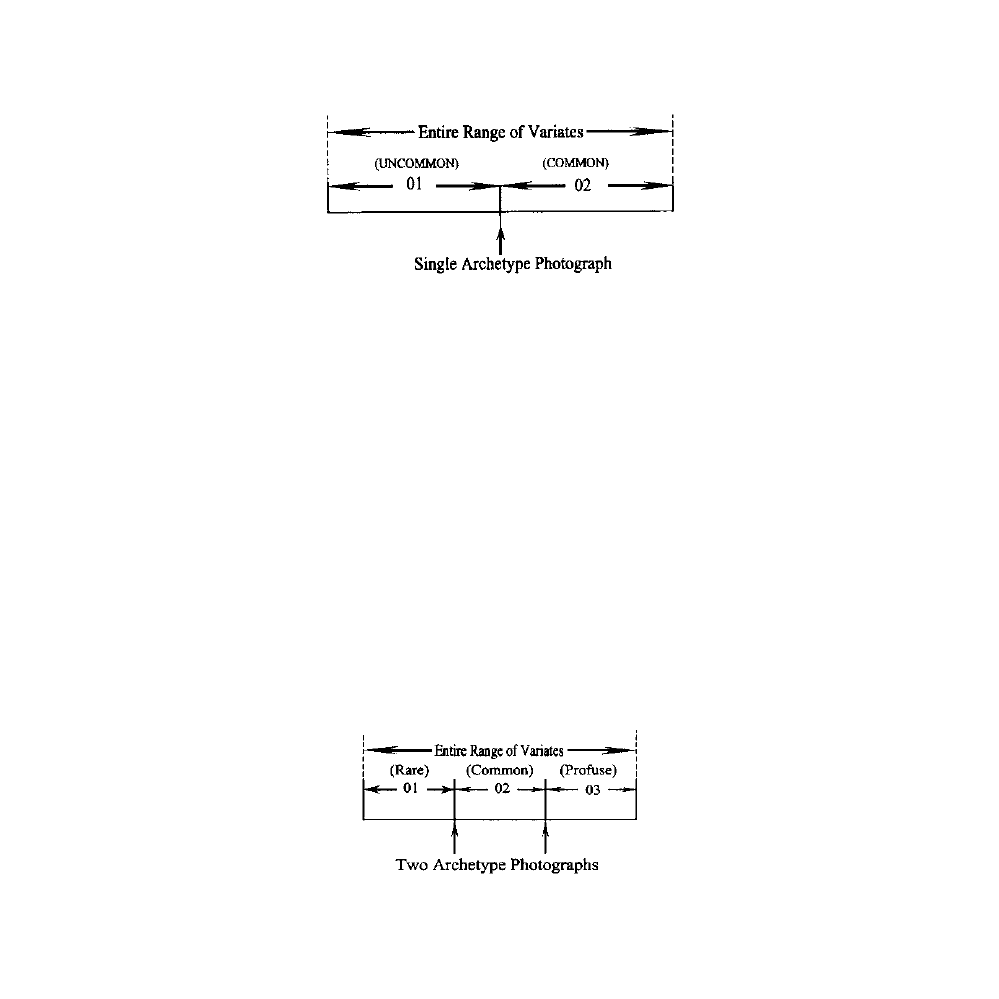
©1999 CRC Press LLC
The system by which a human hair characteristic with continuous vari-
ation is determined is illustrated in
Figures 1.1
and
1.2
.
Figure 1.1
illustrates
the division of a microscopic characteristic into two variate classes with the
use of a single photographic archetype. The variate of the study hair is
categorized either as being below the archetype (uncommon) or as being
equal to or above the archetype (common) with regard to the commonness
of the characteristic in the hair.
Figure 1.2
illustrates the division of a micro-
scopic characteristic into three variate classes with the use of two archetypes.
A study hair’s variate is selected depending on whether the variate falls below
the first archetype (rare), is equal to the first archetype or between the first
and second archetype (common), or is equal to the second archetype or
higher than the second archetype (profuse). The same method is used for
dividing continuous variation into four or more variate classes. The adoption
of three archetypes will split a characteristic into four variate classes. Four
archetypes will split a characteristic into five variate classes, and so on.
For those characteristics with discontinuous variation, the variate of the
study hair is determined by comparing the study hair to the photographic
archetype and selecting which archetype is most similar to the study hair.
Those characteristic variates which are determined by measurement are
Figure 1.1
Variate class limits for two classes determined by one photographic
archetype.
Figure 1.2
Variate class limits for three classes determined by two photographic
archetypes.

©1999 CRC Press LLC
scored based on the measured value. Once the characteristic variate is deter-
mined, a score is assigned to that particular variate. The scores are alphanu-
meric identifiers which are listed for each characteristic variate in
Table
2.1
,
Table 3.1
, and
Table
4.1
. An illustration of the alphanumeric score generated
for the characteristics of a single hair is outlined in Chapter 6.
The examiner should be consistent when determining the variate scoring
for a single hair. Note that the scoring of a particular hair may differ when
the hair is scored proximally, medially, and distally. For that reason, the
examiner or researcher should score the hair in the medial region, at least 2
cm distal to the hair root. In those hairs which vary significantly along the
shaft, it may be necessary to describe the hair as a polytype and record three
hair types designated by the scores taken at the proximal, medial, and distal
areas. The examiner should also be consistent when deciding how to score a
particular characteristic variate. The scoring for an observed variate which
is too close to one of the variate class limit archetypes to be scored unam-
biguously should be scored as belonging to the variate class having the higher
score. That approach will ensure consistency for scoring from hair to hair by
the same examiner and for scoring of the same hair by two or more exam-
iners. Scoring in a consistent manner will allow data from different examiners
to be combined.
1.5 Materials and Methods
Many of the hair specimens used for inclusion in the atlas consisted of
previously prepared permanent microscope slide mounts from the authors’
collections and from the collection of James Bailey of the Los Angeles Sheriff ’s
Department Criminalistics Laboratory. Additional hair specimens were solic-
ited from the authors’ friends, associates, and professional colleagues. The
hair preparations for the atlas photographs were constructed using a template
composed of two 1
¥
3 in. microscope slides taped to a stiff matte board with
adequate space between the slides to place a third slide between the two (see
Figure 1.3
). The two side slides (A, B) were covered with double-sided adhe-
sive tape so that segments of the study hair could be anchored temporarily
across the surface of the permanent slide (S) in the center. The study hair
segments were then taped to the double sided tape on the outside slides so
that the resultant slide mount contained serial segments of the study hair
with the root at the top, the tip at the bottom, and the consecutive shaft
segments between the root and tip ends. After the hair segments were placed
on the slide in this manner and mounting medium was added and covered
with a cover slip, the mounting medium was allowed to cure, and the hair
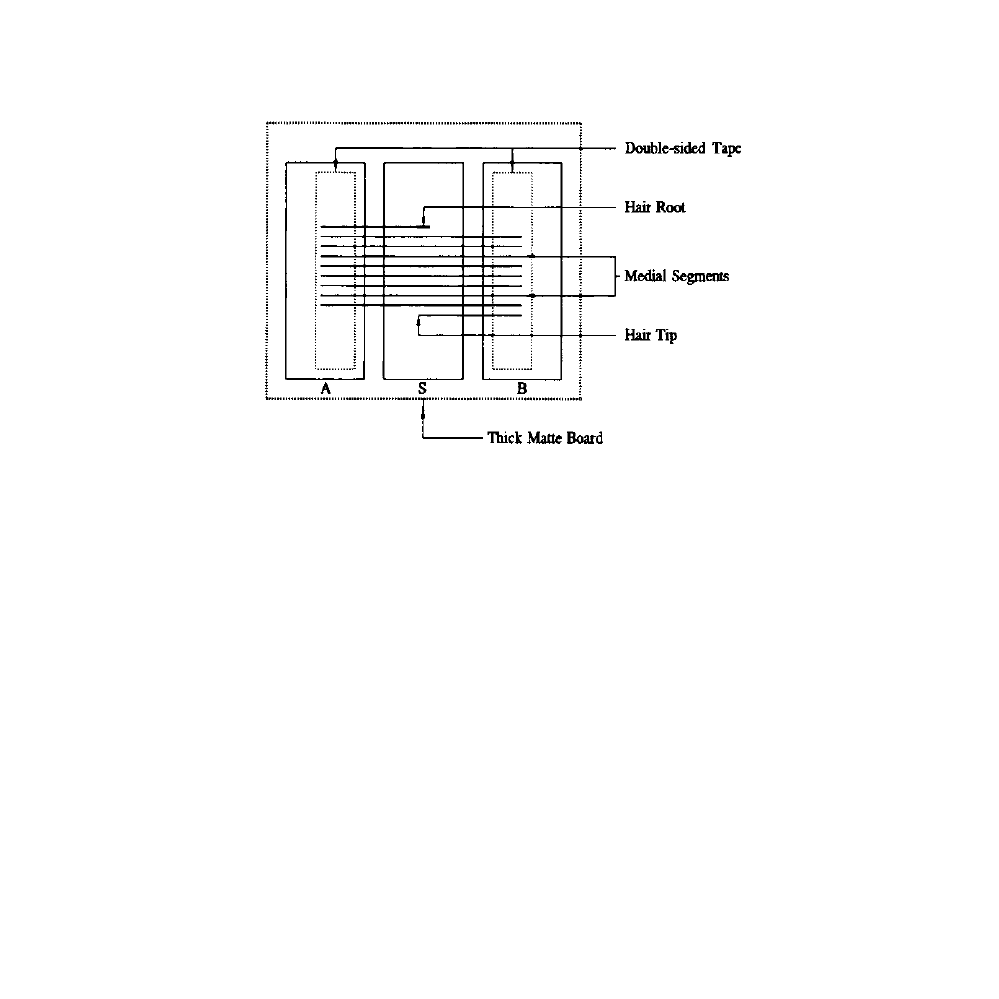
©1999 CRC Press LLC
segments were trimmed at the edge of the study slide. It was found that this
method of hair preparation allowed for an efficient survey of the microscopic
characteristics along the length of the hair from the root to the tip. Note that
this method of hair preparation is suitable only for research specimens and
should not be used for evidential specimens.
Some of the hairs were prepared using mounting medium Accumount™
(Baxter Scientific, McGaw Park, IL), refractive index of approximately 1.500.
Other preparations were made using mounting medium Norland Optical
Adhesive™ (Norland Products, Inc., New Brunswick, NJ), refractive index of
approximately 1.520. The range for refractive index of human hair is approx-
imately 1.543 to 1.554.
4
Selecting a mounting medium with a refractive index
close to the range of the refractive index of human hair allows the examiner
to more easily observe the microscopic characteristics without the interfer-
ence of contrast. A mounting medium with a refractive index in the range
of approximately 1.50 to 1.55 is recommended.
Photographs of the characteristic variates were taken through a trinoc-
ular light microscope using Kodak Ektrachrome® (Eastman Kodak, Roches-
ter, NY) Tungsten film, ASA 160. The use of tungsten slide film has a number
of advantages over other film types. The principal advantages of using tung-
sten slide film include the ability to convert the slide image to a photographic
print or a scanned image, the availability of the slides for use as teaching
aides, the ease with which the examiner or researcher can achieve color
Figure 1.3
Hair slide preparation layout.

©1999 CRC Press LLC
balance with this film type, and the lack of light intensity loss experienced
due to the necessity for color filters with other types of film. The microscope
settings were kept constant (e.g., Kohler illumination) for all microphotog-
raphy. The majority of photographs were taken with a 40
¥
objective and a
2.5
¥
photo ocular. Those characteristics needing higher magnification for
proper viewing of the resultant slide were taken using a 100
¥
oil immersion
objective with the 2.5
¥
photo ocular. Photographs taken at lower magnifica-
tions were performed using either a 4
¥
, a 10
¥
, or a 20
¥
objective with the
2.5
¥
photo ocular.

©1999 CRC Press LLC
Human Hair Macroscopic
Characteristics
Although this atlas was designed primarily to present photographic arche-
types for the variates of microscopic hair characteristics, a description of the
macroscopic characteristics of hair form, degree of curl, and length have been
included (
Table 2.1
). In addition to hair form, curl, and length, the exami-
nation of hair color at the macroscopic level can also be an important part
of a hair comparison. However, the authors have chosen to present color as
determined microscopically (see Chapter 3).
2.1 Hair Form
Hair form refers to the general appearance of the hair with regard to curl. A
definitive measurement of curl is discussed in Section 2.2. For the purpose
of describing hair form, the terms Straight, Curved, Wavy, Loose Curl, and
Tight Curl are presented. For clarification purposes, some of the definitions
for those terms include reference to data generated by the Degree of Curl
Template presented in Section 2.2. Straight hair is defined in this atlas as hair
with no curvature, or hair that has a curvature less than that of a circle having
a diameter of greater than 80 cm (see Degree of Hair Curl below). Curved
hair is defined here as hair that has a slight curvature but does not exhibit
waviness or does not curl back upon itself to form a circle when the hair is
placed on a flat surface. Wavy hair is defined as hair that has curvature that
changes its direction to produce a sinuous wave form and does not curve
back upon itself to form circle-like figures when placed on a flat surface.
Curly hair is defined as hair that curls back upon itself to form circles or
circle-like forms when placed on a flat surface. It is divided into Loose Curl
and Tight Curl. The term Loose Curl is used to describe hair that forms
2

©1999 CRC Press LLC
circle-like figures with a degree of curl from 04 to 06 on the Degree of Curl
Template (
Figure 2.1
). The term Tight Curl describes hair that has a curl
from 07 to 09 on the Degree of Curl Template (
Figure 2.1
).
2.2 Degree of Hair Curl
A template based on the measurement of curvature by Bailey and Schliebe
5
is presented, which can be used to determine the degree of curl present in a
study hair (see
Figure 2.1
). The template was designed so that a study hair
can be placed between two clear plates and set over the template. The degree
of curvature of the hair can be readily determined by comparing the hair to
the curvatures of known circle diameters. The hair can thus be scored by
reference to the numerical values indicated on the curl template (
Figure 2.1
).
For those situations in which more than one measured curvature value
applies to a single hair, the value representing the maximum curl (the smallest
diameter) should be documented.
The shape of the cross-section is related to the natural curl of the hair.
6
Naturally straight hairs have a cross-sectional shape that is near circular.
Naturally curly hairs have a cross-sectional shape that is oval to flattened,
depending on the degree of curl. The correlation between natural degree of
curl and cross-sectional shape indicates that cross-sectional shape and degree
of curl do not necessarily represent two distinct, independent variates. The
use of this atlas in developing correlation data for the macroscopic and
microscopic hair characteristics may help clarify the relationship between
degree of hair curl and cross-sectional shape.
Table 2.1 Macroscopic Characteristics of Human
Hair
a
01.
Hair Form
A00
Straight
A01
Curved
A02
Wavy
A03
Loose Curl
A04
Tight Curl
02.
Degree of Curl
b
B00
> 80
B01
<=
80
B02
<=
40
B03
<= 20
B04
<= 10
B05
<= 5
B06
<= 3
B07
<= 2
B08
<= 1
B09
<=
0.5
03.
Shaft Length
C01
< 2.5 cm
C02
2.5 -> 7.5 cm
C03
7.5 -> 15 cm
C04
15 -> 30 cm
C05
> 30 cm
a
Table 2.1 adapted from Tables 1 and 2, Ogle, R. R., Jr., Individualization of human
hair: the role of the hair atlas,
Microscope
, 46(1), 19, 1998. With permission.
b
Centimeter of circle described by arc of hair curl, judged by comparison to
template.
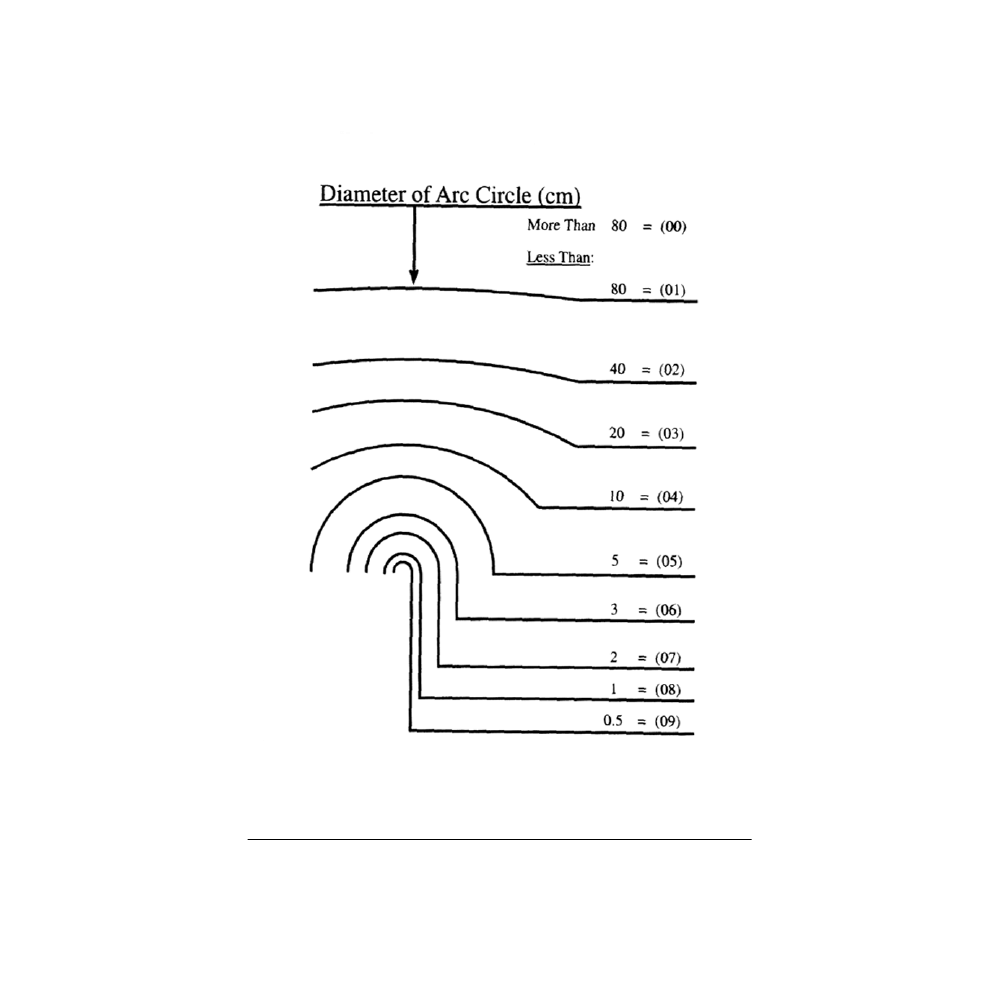
©1999 CRC Press LLC
2.3 Shaft Length
The shaft length is defined as the entire length of the hair, and it is expressed
in centimeters, although the examiner may convert the length into inches in
parentheses if desired. The shaft length is determined by manually straight-
Figure 2.1
Hair curvature measurement template.

©1999 CRC Press LLC
ening the hair next to a ruler. The shaft length may be an important char-
acteristic if the hairs from a known source and the questioned hairs are
collected within a short time frame. If some time has elapsed between the
deposition of the questioned hair(s) and the collection of known hairs from
a suspected source, the possibility of significant hair growth or a haircut by
the suspected source individual should be considered when evaluating a
comparison of length. Examination of the distal hair shaft tips may provide
evidence of the presence or absence of a recent haircut, which would impact
the significance of the hair shaft length as a comparison characteristic. Shaft
length is determined by simple measurement and therefore is not represented
in the photographic archetypes.

©1999 CRC Press LLC
Human Hair Microscopic
Characteristics
This chapter presents a description of each microscopic characteristic that
plays an important role in the forensic comparison of human hair. The
microscopic hair structures useful to the forensic hair examiner include the
cuticle, the medulla, and the cortex. The cuticle consists of overlapping scales
which cover the hair shaft. The medulla is the canal of air or liquid-filled
cells in the center of the cortex. The cortex is the main body of the hair which
consists of keratinized fibers oriented parallel to the long axis of the hair and
which contains a number of inclusions that are outlined and described
throughout this chapter.
Table 3.1
lists and describes those microscopic char-
acteristics of the human hair that are of value to the forensic hair examiner,
with a description of each characteristic and its variates. The photographic
archetypes that demonstrate each microscopic characteristic and its variates
are located in Chapter 5.
3.1 Color
The dominant human hair characteristic useful for forensic hair compari-
sons, both macroscopically and microscopically, is hair color. The color of
the hair depends on the pigment present, the surface transparency, and the
reflectivity of the hair.
7
There are two observed pigments that account for
the color of human hair. Melanin is the brown pigment, and phaeomelanin
is the red pigment. Pigment granules of phaeomelanin are not observable
with light microscopy owing to the small size of the granules.
8
For a detailed
discussion of the chemistry, structure, and physiology of the various mela-
nins, see Cesarini.
9
3

©1999 CRC Press LLC
Table 3.1 Microscopic Characteristics of Human Hair
a
01.
Color:
Colorless
D00
Color Absent (White/Gray Hair)
Blond
D01
Light
D02
Light to Medium
D03
Medium to Dark
D04
Dark
Golden Brown
D11
Light
D12
Light to Medium
D13
Medium to Dark
D14
Dark
Brown
D21
Light
D22
Light to Medium
D23
Medium to Dark
D24
Dark to Opaque
D25
Opaque
Gray Brown
D31
Light
D32
Light to Medium
D33
Medium to Dark
(Black)
D34
Dark (Black) to
Opaque
Red
D41
Light
D42
Light to Medium
D43
Medium to Dark
D44
Dark
Red Brown
D51
Light
D52
Light to Medium
D53
Medium to Dark
D54
Dark
Other
D61
Other (Hair color not found in above color scheme)
Specify Color
02.
Pigment Density
E00
Absent
E01
Light
E02
Light to Medium
E03
Medium to
Heavy
E04
Heavy to Opaque
E05
Opaque
03.
Pigment Granule Size
F00
Absent/Obscured
F01
Fine
F02
Coarse
04.
Pigment Distribution
G00
Absent
G01
Uniform
G02
Peripheral
G03
One-sided
G04
Central
G05
Random
G06
Other
05.
Pigment Aggregate Shape

©1999 CRC Press LLC
H00
Absent/No
Aggregates
H01
Streaked
H02
Clumped
H03
Other
06.
Pigment Aggregate Size
I00
Absent/No
Aggregates
I01
Small Streaks
I02
Medium Streaks
I03
Large Streaks
I04
Small Clumps
I05
Medium Clumps
I06
Large Clumps
I07
Other
07.
Medulla Continuity
J00
Absent/Obscured
J01
Continuous
J02
Interrupted
J03
Fragmentary
J04
Continuous/
Interrupted
J05
Continuous/
Fragmentary
J06
Interrupted/
Fragmentary
J07
Continuous/Interrupted Fragmentary
08.
Medulla Opacity
K00
Absent/Obscured
K01
Opaque
K02
Translucent
K03
Opaque/
Translucent
09.
Cuticle Thickness
L01
Thin
L02
Thick
L03
Varies
L04
Not Apparent
10.
Inner Cuticle Margin
M01
Indistinct
M02
Distinct
M03
Varies
11.
Outer Cuticle Scale Profile
N01
Smooth
N02
Serrated
N03
Ragged
N04
Looped
N05
Other
12.
Cuticle Surface
O01
Normal
O02
Damaged
13.
Pigment in Cuticle
P01
Absent
P02
Present
14.
Cortical Texture
Q00
Absent
Q01
Present
Q02
Obscured
15.
Cortical Fusi
R00
Absent
R01
Root Only
R02
Rare
R03
Common
R04
Profuse
R05
Obscured
16.
Ovoid Bodies
S00
Absent
S01
Few
S02
Many
S03
Obscured
17.
Root Growth Stage
T00
Absent
T01
Anagen
T02
Catagen
T03
Telogen
18.
Distal Tip Characteristics
U01
Natural Taper
U02
Rounded Taper
Table 3.1 Microscopic Characteristics of Human Hair
a
(continued)

©1999 CRC Press LLC
The hair colors and shades presented in this atlas were determined using
a comparison light microscope. The authors have grouped the variates for
hair color into the following: Blond, Golden Brown, Brown, Gray Brown,
Red Brown, Red, and Other. Each color is presented in Chapter 5 as a series
of three archetype photographs that partition the color into four ranges of
shades of that color. When determining the color and shade of a study hair,
U03
Square
Cut/Straight
Edge
U04
Angled
Cut/Straight
Edge
U05
Square
Cut/Rounded
Edge
U06
Angled
Cut/Rounded
Edge
U07
Split
U08
Frayed
U09
Crushed
U10
Singed
U11
Broken
U12
Other
19.
Maximum Shaft Diameter
V01
Fine
V02
Medium
V03
Coarse
(< 40 microns)
(40 to 80
microns)
(> 80
microns)
20.
Shaft Aberration
W00
Normal
W01
Buckling
W02
Shouldering
W03
Splitting
W04
Undulating
W05
Convoluting
21.
Hair Treatments
X00
Absent/Not
Apparent
X01
Dyed
X02
Bleached
X03
Permed
X04
Combination
X05
Other
22.
Hair Diseases and Disorders
Y01
Trichorrhexis
Nodosa
Y02
Trichorrhexis
Invaginata
Y03
Trichoschisis
Y04
Pili Annulati
Y05
Monilethrix
Y06
Pili Torti
Y07
Trichonodosis
Y08
Cartilage Hair
Hypoplasia
Y09
Other
23.
Miscellaneous Characteristics
Z01
Double Medulla
Z02
Streaky Medulla
Z03
Gapping Pigment
Z04
Debris Present
Z05
Trailing Ovoid
Bodies
Z06
Other
24.
Insect, Arachnid, and Fungal Presence and Damage
AA01
Lice/Louse Eggs
AA02
Insect/Arachnid
Damage
AA03
Fungal Damage
AA04
Other
a
Table 3.1 adapted from Tables 1, 2, and 4, Ogle, R. R., Jr., Individualization of human hair: the
role of the hair atlas,
Microscope
, 46(1), 19, 1998. With permission.
Table 3.1 Microscopic Characteristics of Human Hair
a
(continued)

©1999 CRC Press LLC
the examiner must recognize the continuous range between each photo-
graphic archetype. For example, there is a continuous range of colors between
Blond and Golden Brown, as well as a continuous range of shades between
Light Golden Brown and Medium Golden Brown. The color of the study
hair is determined by selecting the color archetype series that is most similar
to that of the study hair. The shade of the study hair is then determined using
the selected color archetype series (the series of three photographs that par-
titions the ranges of shades for the selected color). The variates for each color
shade include Light, Light to Medium, Medium to Dark, and Dark and are
partitioned using three photographic archetypes. The authors acknowledge
that the palette of colors and shades presented in this atlas may be limited.
Some naturally colored hairs and some artificially colored hairs may not be
represented here. Such hairs should be scored as the variate Other. Future
research into hair pigments may refine this color scheme considerably.
The color and shade of a hair that has an oval or flat cross-sectional shape
may vary depending on the orientation of the hair under the microscope. Hairs
with oval or flat cross-sectional shapes that are oriented on their side might
appear darker. As a general rule, all microscopic characteristics should be
determined with the hair oriented such that the maximum shaft diameter (i.e.,
the maximum diameter of the cross-sectional shape) is being observed. Other
characteristics that might be affected by the orientation of the hair include
Pigment Density (Section 3.2) and Pigment Distribution (Section 3.4).
3.2 Pigment Density
Pigment density refers to the abundance of pigment granules observed using
light microscopy. Pigment density is a continuous variate when applied to
the entire human population. Thus, the number of possible variations in the
density of human hair likely approaches infinity. The archetypes established
by the authors for the purposes of this atlas divide pigment density into the
following variates: Absent, Light, Light to Medium, Medium to Heavy, Heavy
to Opaque, and Opaque. Those variates are partitioned using three photo-
graphic archetypes; a fourth archetype represents an Opaque hair. The pho-
tographic archetypes are presented in Chapter 5. Human hair researchers
may wish to add more variates to this characteristic when studying small
populations that might demonstrate pigment density variation within only
one of the variates defined here.
The density of pigment granules appears to be highly correlated with
microscopic hair color and therefore may represent a redundant hair char-
acteristic in the context of forensic hair comparisons. The development of
frequency data may more clearly define the relationship between pigment

©1999 CRC Press LLC
density and hair color. It is clear, however, that the correlation between hair
color and pigment density is very high. One might say that color is in fact
the result of the ensemble of pigment size, density, and distribution (along
with the optical properties of the cuticle and cortex).
3.3 Pigment Granule Size
Pigment granule size refers to the size of the individual melanin pigment
granules as judged by comparison to the archetypes. The variates of pigment
size include Absent/Obscured, Fine, and Coarse. Examples of Fine and Coarse
pigment granules are presented in Chapter 5. The term Absent/Obscured can
refer to either the absence of pigment (e.g., white or gray hairs) or the inability
to resolve individual pigment granules using light microscopy. The inability
to resolve individual pigment granules may be due to the small size of the
granules (e.g., phaeomelanin pigment) or the obscured effect caused by heavy
pigmentation when looking at the hair in a longitudinal mount (e.g., opaque
hair). If the examiner deems it necessary, the pigment granule size of heavily
pigmented hairs can be observed either by cross-sectioning the hair or by
slicing the hair lengthwise into tapering sections. The pigment granules of
hair containing phaeomelanin pigment (red hair) may be seen using scanning
electron microscopy.
10
Hairs containing only phaeomelanin pigment will
probably be scored as Absent/Obscured (not visible) with regard to pigment
size when viewed using light microscopy.
With further use of the scanning electron microscope, researchers may
want to designate variate categories based on measured sizes rather than on
comparative sizes. That approach may add additional variate categories for
the researcher, or it may indicate that the variates listed here suffice for
classification purposes.
3.4 Pigment Distribution
Pigment distribution refers to the distribution and concentration of the
pigment granules in various areas of the hair shaft. The variates for pigment
distribution are Absent, Uniform, Peripheral, One-sided, Central, Random,
and Other. Photographic archetypes illustrating each form of pigment dis-
tribution are presented in Chapter 5. The term Absent refers to the absence
of pigment in the hair shaft (e.g., white or gray hair). Uniform refers to
pigment that is evenly distributed across the cortex of the hair. Peripheral
refers to pigment that is concentrated at the outer edges of the shaft. One-
sided refers to pigment that is concentrated on one side of the shaft. Central
refers to pigment that is concentrated (or appears to be concentrated) in the

©1999 CRC Press LLC
center of the shaft. Random refers to pigment that is found in greater con-
centrations in some areas of the shaft and in lesser concentrations in other
areas of the shaft, with no recognizable pattern. Hairs that contain sparse
amounts of pigment (with random areas of the cortex completely absent of
pigment) would be categorized as having a random pigment distribution.
The term Other refers to pigment distribution that does not fit any of those
variate categories.
Pigment distribution normally can be judged adequately by viewing
the hair shaft in the longitudinal mount. The orientation of the hair should
be such that the maximum shaft diameter (i.e., the maximum cross-sec-
tional shape) is being observed. In the case of blond or red hair, individual
pigment granules may not be resolved using light microscopy, and the
pigment may appear to be more concentrated centrally, owing to the dif-
ference between the length of the light path through the central portion of
the shaft and the length of the light path nearer the edge of the shaft. When
scoring the pigment distribution for those hairs, the examiner should cat-
egorize the hair as having central distribution, even though the distribution
may be an artifact resulting from optical effects. Some examiners may find
it necessary to examine a cross-section of the shaft to determine and doc-
ument the actual pigment distribution.
3.5 Pigment Aggregate Shape
Pigment aggregate shape refers to the appearance of the pigment granules
when they are concentrated in a mass that has a recognizable form. The
variates for pigment aggregate shape are Absent/No Aggregates, Streaked,
Clumped, and Other. Photographic archetypes illustrating each variate of
pigment aggregate shape are presented in Chapter 5. The variate Absent/No
Aggregates can refer to either the absence of pigment (e.g., a white or gray
hair) or a pigmented hair that exhibits no aggregation. Aggregated pigment
granules may appear streaked or clumped, both of which can be judged by
reference to the archetypes presented in the atlas. In those hairs for which
aggregation exists but cannot be clearly categorized as Streaked or Clumped
(e.g., opaque hair) or for those hairs that appear to have a mixture of streaked
aggregates and clumped aggregates, the hairs should be categorized as Other.
3.6 Pigment Aggregate Size
Pigment aggregate size refers to the size of the aggregates as judged by com-
parison to the archetypes. Aggregate size is described as Absent/No Aggre-
gates, Small Streaks, Medium Streaks, Large Streaks, Small Clumps, Medium

©1999 CRC Press LLC
Clumps, Large Clumps, and Other. The variates are partitioned using the
four photographic archetypes presented in Chapter 5. The variate descriptor
Absent/No Aggregates can refer to either the absence of pigment or the
absence of pigment aggregation. The aggregate size is determined by com-
parison to the archetypes. As with the variates for pigment aggregate shape,
there may be an intergrade in a particular study hair that is too close to the
archetype to assess whether the study hair falls in the variate class above or
below the archetype. If that happens, the examiner should follow the con-
vention of categorizing the study hair variate as belonging to the higher
variate class. In those hairs for which aggregation exists but cannot be clearly
categorized in one of the listed variates, the variate Other would apply.
3.7 Medulla Continuity
Medulla continuity refers to the nature of opaque and translucent forms
(see Section 3.8) of the medulla from the proximal end to the distal end
of the hair shaft. The medulla form in human hairs can be described as
amorphous, since the medulla normally does not have a discernible internal
pattern such as the complex, structural patterns found in many nonhuman
hairs. The continuity of a medulla along the shaft does, however, often have
a discernible pattern. The primary continuity patterns seen in human hair
medullas consist of Absent, Continuous, Interrupted and Fragmentary, or
combinations of those patterns. These terms refer to both the translucent
and the opaque forms of the medulla. Photographic archetypes illustrating
each medulla continuity variate are presented in Chapter 5. The term
Absent refers to hairs with no visible medulla, including those hairs with
no visible medulla due to heavy pigmentation. The term Continuous refers
to a medulla that extends along the shaft with no interruption. The term
Interrupted refers to the same condition described by Hicks as Discontin-
uous. Hicks defines the term Discontinuous (Interrupted) as the condition
where the lengths of the visible medulla are greater than the lengths of the
indiscernible portions of the medulla, and he defines the term Fragmentary
as the condition when the lengths of the indiscernible portions of the
medulla exceed the lengths of the discernible portions.
11
For purposes of
this atlas, a discernible portion is defined as a visible medulla portion
regardless of whether it is opaque or translucent.
When combinations of the medulla continuity patterns are observed in
a hair, the hair is scored as either Continuous/Interrupted, Continuous/Frag-
mentary, Interrupted/Fragmentary, or Continuous/Interrupted/Fragmen-
tary. It should be noted that a medulla (the medullary cells) may not be
visible (Absent), or it may be visible regardless of whether it is opaque or

©1999 CRC Press LLC
translucent. In some hairs, a “continuous” medulla may have portions that
are opaque and portions in which the medullary cells are visible and trans-
lucent. Traditionally, some examiners have judged the continuity of the
medulla based on the continuous nature of the opaque form only. The
approach suggested here is to judge the continuity of the medulla based on
both the opaque and translucent forms.
3.8 Medulla Opacity
Medulla opacity refers to the appearance of the medulla as viewed with
transmitted light in the compound light microscope. The variates for
medulla opacity include Absent, Opaque, Translucent, and Opaque/Translu-
cent. Photographic archetypes illustrating each form of medulla opacity are
presented in Chapter 5. The term Absent refers to hairs with no visible
medulla, including those hairs in which the medulla is obscured due to heavy
pigmentation. When the medulla is filled with air, it will appear opaque under
a microscope. When the medulla is filled with liquid, it will appear translu-
cent. Some hairs contain a medulla that has both opaque and translucent
segments along their shafts. These hairs are scored as Opaque/Translucent.
3.9 Cuticle Thickness
The cuticle is the layer of overlapping scales that forms the outer layer of the
hair. The variates for cuticle thickness are based on measurement and include
the terms Thin, Thick, Varies, and Not Apparent. Measurement of the cuticle
should be performed at the maximum shaft diameter and is determined by
measurement with an ocular micrometer calibrated with a stage micrometer.
The term Thin refers to a cuticle thickness of less than 2.5 µm. The term
Thick refers to a cuticle thickness of 2.5 µm or greater. The term Varies refers
to those hairs where the cuticle thickness varies along the shaft at or near the
widest diameter. The term Not Apparent refers to cuticles that are not easily
measured due to an indistinct inner cuticle margin (see Section 3.10).
3.10 Inner Cuticle Margin
The inner cuticle margin refers to the border between the cuticle and the
cortex. The variates of the inner cuticle margin consist of Indistinct, Distinct,
and Varies as viewed longitudinally. Photographic archetypes illustrating
each variate of inner cuticle margin are presented in Chapter 5. The term
Indistinct refers to the condition when the inner margin of the cuticle may

©1999 CRC Press LLC
not be visible or is not well defined. The term Distinct refers to the condition
when the border between the cuticle and the cortex is readily apparent and
is well defined. The term Varies refers to those hairs with an inner cuticle
margin that varies in its distinctness due to a variation in pigment density
along the inner margin. There appears to be a correlation between pigment
density and the distinctness of the inner cuticle margin. Heavily pigmented
hairs tend to have relatively distinct margins, and lightly pigmented hairs
tend to have relatively indistinct margins. Experimental data with regard to
establishing the correlation coefficient for these two variates can be accom-
plished for study populations by a researcher.
3.11 Outer Cuticle Scale Profile
The term Outer Cuticle Scale Profile refers to the pattern of the outermost
edge of the cuticle jutting from the hair surface when the hair is viewed in
the longitudinal mount. The condition of the cuticle profile can be natural
or the result of environmental factors (e.g., hair treatments). The variates of
the cuticle profile are Smooth, Serrated, Ragged, Looped, and Other. Photo-
graphic archetypes illustrating each variate of cuticle profile are presented in
Chapter 5. The term Smooth refers to a cuticle profile that is even or flat.
The term Serrated refers to a cuticle profile that is “saw-toothed.” The term
Ragged refers to a cuticle profile that is uneven and irregular. The term
Looped refers to the condition when the scales are curved at their distal edges
so that they cup, or arch, at the edge of the shaft. Looped scales can trap air
below the curved portion, giving the appearance of a dark band between the
scale and the shaft. The variate Other refers to either hairs that have a
combination of cuticle conditions or hairs that have a cuticle profile that
cannot be categorized as Smooth, Serrated, Ragged, or Looped.
3.12 Cuticle Surface
Cuticle Surface refers to the condition of the scales on the surface of the
cuticle as seen in a longitudinal air mount or in a scale cast prepared by the
method of Ogle
12
or Hicks.
13
The cuticle surface variates described here are
Normal and Damaged. Photographic archetypes illustrating Normal and
Damaged cuticle surfaces are presented in Chapter 5. The term Normal refers
to a cuticle surface that does not have any discernible damage when viewed
in the compound microscope. The term Damaged refers to a cuticle surface
that has discernible damage due to hair treatments or to damage from envi-
ronmental effects.

©1999 CRC Press LLC
3.13 Pigment in Cuticle
The variates for pigment in cuticle include Present or Absent. Photographic
archetypes illustrating each are presented in Chapter 5. The presence of
melanin pigment granules in the cuticle appears to be correlated with pig-
ment density. The presence of pigment in the cuticle is more commonly
observed in heavily pigmented hairs. Experimental data with regard to estab-
lishing the correlation coefficient for these two variates can be accomplished
for study populations by a researcher.
3.14 Cortical Texture
Cortical texture refers to the appearance of the cortex as viewed in a longi-
tudinal mount. The variates for cortical texture are Absent, Present, and
Obscured. Photographic archetypes illustrating each variate for cortical tex-
ture are presented in Chapter 5. The cortex may have no apparent texture
(Absent), it may demonstrate a streaky texture (Present), or the ability to
observe the cortical texture may be obstructed due to heavy pigmentation
(Obscured). The “streaky” nature of the cortical texture may be due to rela-
tively sizeable bundles of fibers that are readily appreciated when the hair is
viewed longitudinally in the microscope. Although the authors have
described cortical texture to be streaked, the variate Present may be applied
to other observed texture forms as well. Examiners should be aware that
stopping down the substage condenser may allow the texture of the cortex
to be more easily observed.
3.15 Cortical Fusi
The cortical fusi are small, fusiform (spindle-shaped) bodies that lie between
the cortical cells of the cortex.
14
They are commonly found in the hair root
and the immediate proximal portion of the hair shaft. Distally, they are more
uncommon and usually exhibit a shrunken appearance. The variates are
defined here as Absent, Root Only, Rare, Common, Profuse, and Obscured.
The variate Absent refers to the absence of cortical fusi. The variate Root
Only refers to hairs that contain cortical fusi in the root only or hairs that
contain cortical fusi in the root and in the proximal end of the hair only. The
variates Rare, Common, and Profuse refer to the concentration of cortical
fusi as they exist along the shaft of the hair in the medial and distal regions.
Those variates are partitioned using the two photographic archetypes pre-
sented in Chapter 5. The term Rare refers to a low concentration of cortical

©1999 CRC Press LLC
fusi along the shaft. The term Common refers to a greater concentration of
cortical fusi along the shaft, and the term Profuse refers to a high concen-
tration of cortical fusi along the shaft. The concentration of cortical fusi is
not presented here as a quantitative measurement but is determined in a
study hair by comparison to the photographic archetypes. The variate
Obscured refers to the inability to observe the presence of cortical fusi due
to obstruction by heavy pigmentation (e.g., opaque hair).
3.16 Ovoid Bodies
Ovoid bodies exist in the hair cortex and are aggregations of pigment that
can have a spheroidal or oblong shape. Ovoid bodies can range in diameter
from 3 to 20 µm; however, this size range may not be all inclusive. The variates
for ovoid bodies relate to the abundance of ovoid bodies present in the hair
shaft. The variates for ovoid bodies include Absent, Few, Many, and
Obscured. The term Absent refers to the absence of ovoid bodies. The term
Few refers to the presence of a small number of ovoid bodies in the shaft.
The term Many refers to the presence of numerous ovoid bodies in the shaft.
To maintain consistency in scoring, the authors recommend the following
quantitative technique: Scan the subject hair from end to end at 200
¥
(other
magnification levels may be used). Determine the number of ovoid bodies
for each field of view. Determine the average number of ovoid bodies per
field of view by dividing the total number of ovoid bodies counted by the
number of fields of view. If the average number counted per field is less than
10, the hair should be categorized as Few. If the average number counted per
field is 10 or more, the subject hair should be categorized as Many.
This quantitative technique may not partition hairs containing ovoid
bodies into two equally sized groups, but it will allow some consistency
between examiners. Research on the abundance of ovoid bodies observed
in a given study population of hairs may reveal either that this quantitative
evaluation does not provide useful comparative information and a different
quantitative technique is more appropriate or that the quantitative evaluation
of ovoid bodies is not feasible.
One limitation to this quantitative technique may be associated with
length. If a portion of the shaft is broken or cut, the average number of ovoid
bodies observed in the remaining portion may result in a different score;
therefore, examiners may need to consider length as a factor when comparing
the abundance of ovoid bodies in a questioned hair to hairs from a known
source. The variate Obscured refers to the inability to observe the presence
of ovoid bodies due to obstruction by heavy pigmentation (e.g., opaque hair).

©1999 CRC Press LLC
3.17 Root Growth Stage
The characteristic variates of the hair root growth stages represent the growth
stage of the hair at the time of its removal or loss from the body and include
Absent, Anagen (active growth phase), Catagen (transitional phase between
anagen and telogen phases), and Telogen (terminal stage prior to the hair
falling out of the hair follicle). The variate Absent refers to those hairs that
do not have a root. A hair pulled from the scalp or pubic region during the
Anagen phase will have an epithelial sheath adhering to an elongated, pig-
mented root. A hair pulled during the Catagen phase may have a slightly
enlarged root and may have some bits of epithelial tissue adherent. The
Catagen phase is a transitional phase, and the root form may vary depending
on whether the phase of a study hair is closest to the Anagen phase or the
Telogen phase. A hair pulled or fallen from the scalp or pubic region during
the Telogen phase typically has an enlarged root bulb that lacks pigment, has
little or no adherent epithelial tissue, and may contain an abundance of
cortical fusi. Photographic archetypes illustrating the Anagen phase and the
Telogen phase are presented in Chapter 5. The growth phase of the hair root
may assist in an assessment of whether or not the hair has been forcibly
removed. The presence of epithelial tissue on a root plays an important role
in hair examination, owing to the ability to analyze the DNA present in the
nuclei of the adherent epithelial cells from the follicular tissue. For a general
discussion of the morphology and forensic significance of human hair roots,
see the article by Petraco et al.
15
For a discussion of DNA analysis of human
hair roots as it pertains to growth stages, see Linch et al.
16
3.18 Distal Tip Characteristics
The characteristic variates of the distal hair tip may relate to the grooming
history of the hair and include Natural Taper, Rounded Taper, Square
Cut/Straight Edge, Angled Cut/Straight Edge, Square Cut/Rounded Edge,
Angled Cut/Rounded Edge, Split, Frayed, Crushed, Singed, Broken, and
Other. Photographic archetypes illustrating each variate of distal tip are
presented in Chapter 5. The shape of the tip may represent whether or not
the hair has been cut and the type of haircut received by the individual. It
also is an indication of whether or not the haircut was recent. A tapered tip
may indicate that no cutting has occurred. The angle and condition of a cut
tip may indicate the type of haircut received. The presence of a sharp cut
edge vs. a rounded cut edge may indicate whether there was a time interval
between the time the hair was cut and the time of its separation from the

©1999 CRC Press LLC
body. Frayed and Split tips typically have a longitudinal separation of the
hair shaft. A Crushed tip typically has a widened shaft. A Singed tip is typically
charred, brittle, exhibits vacuoles (cavities in the cortex) in the damaged area,
and may have a yellow cast. A Broken tip may take on a number of forms,
and the examiner should be aware that Broken tips can sometimes appear
like Square Cut tips. Examination and comparison of hair tip variates may
strengthen the linkage of a questioned hair to a known specimen when the
same variates are seen in both the known and questioned hair samples.
3.19 Maximum Shaft Diameter
The maximum diameter of the hair shaft is determined by measurement with
an ocular micrometer calibrated with a stage micrometer. The Maximum
Shaft Diameter is the widest diameter along the shaft axis (when scanning
from root to tip) and the widest cross-sectional diameter. For example, the
cross-section of a curly hair is usually oval or flat. It is the widest dimension
of the oval or flat cross-sectional shape that should be considered when
measuring the Maximum Shaft Diameter. The diameter variates are defined
as Fine (less than 40 microns), Medium (40 to 80 microns), and Coarse (more
than 80 microns). Since simple measurement accurately categorizes this vari-
ate, there are no photographic archetypes presented.
3.20 Shaft Aberration
Shaft aberration refers to a departure from the “normal” hair shaft, which
usually has a relatively uniform diameter from the root to an area near the
tip and has a relatively smooth exterior without abrupt changes as seen in
the longitudinal mount. Most shaft aberrations occur naturally, but some
can result from hair treatment, environmental factors or disease. The variates
for shaft aberration include Normal, Buckling, Shouldering, Splitting, Undu-
lating, and Convoluting. Photographic archetypes illustrating each form of
shaft aberration are presented in Chapter 5.
Shaft aberration typically is seen in pubic hairs; however, some shaft
aberrations are also associated with beard hair and with the scalp hair of
individuals with African heritage. The variate Absent indicates that the hair
shaft has no disruption. Buckling is an abrupt bend in the shaft with or
without a twist. Shouldering refers to a condition in which one side of the
hair is thicker, causing a shoulder along the shaft. Shouldering is best
observed in a cross-sectional mount, but it may be detected in the longi-
tudinal mount by focusing through the hair and observing the thickness
of the shaft. Splitting refers to a split of the medial portion of the shaft

©1999 CRC Press LLC
(that does not include splitting at the ends). Undulating refers to a shaft
that demonstrates true diameter variation along the length of the hair,
causing the edges of the shaft to take on a wave form. Convoluting refers
to a twisted hair. A convoluting hair typically has an oval or flat cross-
section. In a longitudinal mount, the diameter of a convoluting hair may
appear to vary, when in reality, the diameter may be constant and the
apparent diameter variation is due to twisting.
3.21 Hair Treatments
Hair treatments can consist of methods to curl, straighten, bleach, and dye
the hair. These treatments may or may not cause damage to the hair cuticle
and shaft. The observation that a questioned hair and known hairs have
received the same treatment may add to the strength of a hair comparison,
but the widespread use of hair treatments may also limit the significance of
the correspondence. The variates for hair treatments include Absent/Not
Apparent, Dyed, Bleached, Permed, Combination, and Other. Photographic
archetypes illustrating examples of each hair treatment are presented in
Chapter 5. The variate Absent/Not Apparent refers to hairs that appear to
have had no treatment with regard to color and curl. The variate Dyed refers
to hairs that show evidence of artificial coloring. The variate Bleached refers
to hairs that have been treated to remove the natural hair color. The variate
Permed refers to hairs that have been treated to alter the natural curl. The
variate Combination refers to hairs that have been treated using more than
one of the previously discussed treatment methods (e.g., some hairs may
have been bleached and subsequently dyed during the same treatment pro-
cess). The variate Other refers to hairs that appear to be treated, but the
observed treatment cannot be categorized as dyed, bleached, or permed.
The result of some treatments may be apparent using light microscopy,
while others are not as easily detected. A hair that has been dyed may be
apparent by the presence of a demarcation line, or a sharp boundary between
the treated portion of the hair and the naturally pigmented newly grown
portion. A dyed hair may also exhibit the dye color in the cuticle. A dyed
hair also will be apparent by the uniformity of the color distribution. Some
hair examiners may recognize a dyed hair based on their observation that
the color of the subject hair is not typical of naturally colored hair.
The bleaching of hair may result from an artificial bleaching process, or
it may result from natural exposure to the sun. A hair that has been bleached
from exposure to sun is often referred to as a solar-bleached hair. A bleached
hair may be recognized by the presence of a demarcation line between the
treated portion and the naturally pigmented newly grown portion. The

©1999 CRC Press LLC
bleached portion may contain no pigment granules, or it may contain sig-
nificantly fewer pigment granules than the natural portion. The demarcation
line of solar-bleached hair typically is not as distinct as the demarcation line
of artificially bleached hair. Repeated dyeing and bleaching of a hair may
result in several lines of demarcation that might render a hair as being
unusual, resulting in a hair comparison that might have greater significance.
Permanent waved hairs sometimes may have buckles or bends in the hair
shaft due to the use of perm curlers. These buckles may present themselves
at roughly even intervals along the hair shaft due to the manner in which
the hair is wrapped around the curler. Artificially straightened hairs some-
times may be recognized by the simple observation that a straight hair has
a cross-sectional shape (e.g., oval, flat) that is more consistent with curly hair.
3.22 Hair Diseases and Disorders
Table 3.1
lists some hair diseases and hair disorders found in human hair.
Hair diseases and disorders are very rare, and their presence in both a ques-
tioned hair and a known hair sample in forensic examinations may
strengthen considerably the opinion that the questioned hair could have
come from the same individual as the known specimen. The hair diseases
listed in
Table 3.1
are Trichorrhexis Nodosa, Trichorrhexis Invaginata, Tri-
choschisis, Pili Annulati, Monilethrix, Pili Torti, Trichonodosis, Cartilage
Hair Hypoplasia, and Other. Discussion of these diseases and disorders is
deferred to Chapter 5 so that the reader may refer to
Figure 5.21.1
, which
illustrates them.
3.23 Miscellaneous Characteristics
Miscellaneous characteristics are those characteristics that do not fit into any
of the other categories listed in the various tables presented in this atlas.
These characteristics are listed in
Table 3.1
. Miscellaneous characteristics
include Double Medulla, Streaky Medulla, Gapping Pigment, Debris Present,
Trailing Ovoid Bodies, and Other. Photographic archetypes illustrating
examples of those miscellaneous characteristics are presented in Chapter 5.
The variate Other may include any other notable characteristic not discussed
here. Any unusual characteristics should be described fully in the notes and
augmented with photographs in the examiner’s or researcher’s case file.

©1999 CRC Press LLC
3.24 Insect, Arachnid, and Fungal Presence and Damage
The insect, arachnid, and fungal presence and damage listed in
Table 3.1
includes lice/louse eggs, insect/arachnid damage, fungal damage, and other.
The presence of louse eggs is easily diagnosed from the characteristic appear-
ance of the egg attached to the hair shaft. Insect or arachnid damage can
usually be diagnosed from the patterned appearance of the damage, while
fungal damage has a more amorphous aspect. The variate Other refers to
biological damage to hair that cannot be categorized easily as insect/arachnid
or fungal damage. Photographic examples of each variate are presented in
Chapter 5.

©1999 CRC Press LLC
Human Hair Cross-Section
Characteristic Variates
Table 4.1
lists the following microscopic characteristic variates as seen in
cross-section mounts of the hair: cross-section shape, cuticle thickness, pig-
ment density, pigment size, pigment distribution, and cortical texture. This
chapter provides a brief description of each cross-section characteristic. Pho-
tographic archetypes that illustrate cross-section shape and cross-section
pigment distribution are presented in Chapter 5. For a discussion on cross-
section techniques, see Fong and Inami.
17
It should be noted that the cross-section view of most characteristics
does not represent additional “characteristics” for the purpose of hair com-
parison but rather adds a different view of the same characteristic. The cross-
section may, however, resolve a question regarding the precise diagnosis of
a characteristic that is difficult to diagnose in the longitudinal mount. The
cross-section may assist in resolving questions regarding the pigment distri-
bution about the medulla, the precise cross-section shape, or the cross-
section cortical texture. Cuticle thickness, pigment density, and pigment size
usually can be easily diagnosed in the longitudinal view by an experienced
examiner.
4.1 Shaft Cross-Section Shape
The hair shaft cross-section shape usually can be diagnosed by an experienced
hair examiner in a longitudinal mount. However, in some cases, the cross-
section view allows the examiner to be more precise and accurate in the
assessment of cross-section shape, since the cross-section gives a direct view
of the shape. The cross-section shape variates are listed as Round, Oval,
Triangular, Flat, Kidney, and Shouldered. The triangular shape is seen often
4

©1999 CRC Press LLC
in beard hairs and rarely in scalp hairs. The cross-section shape of the tran-
sitional hairs between the scalp and the beard area have not been studied
adequately. Straight hairs typically will have a round cross-section shape. As
the degree of curl increases, the cross-section shape becomes increasingly
flattened so that the curliest hairs will exhibit the flattest shape.
18
Photo-
graphic archetypes representing each cross-section shape are presented in
Chapter 5.
4.2 Cross-Section Cuticle Thickness
The variates for cross-section cuticle thickness are Thin, Thick, and Varies.
Those categories correspond to the same categories as seen in the longitudinal
mount and do not require photographic archetypes.
4.3 Cross-Section Pigment Density
The variates for pigment density in cross-section are the same as those for
the longitudinal mount and therefore do not require photographic arche-
types.
Table 4.1 Human Hair Cross-Section Characteristics
a
0.1
Shape
BB01
Round
BB02
Oval
BB03
Triangular
BB04
Flat
BB05
Kidney
BB06
Shouldere
d
02.
Cuticle Thickness
CC01
Thin
CC02
Thick
CC03
Varies
03.
Pigment Density
DD01
Light
DD02
Medium
DD03
Heavy
DD04
Opaque
04.
Pigment Granule Size
EE01
Fine
EE02
Coarse
05.
Pigment Distribution
FF01
Uniform
FF02
Peripheral
FF03
Central
FF04
One-sided
06.
Cortical Texture
GG01
Absent
GG02
Present
GG03
Obscured
a
Table 4.1 adapted from Table 3, Ogle, R. R., Jr., Individualization of human
hair: the role of the hair atlas,
Microscope
, 46(1), 20, 1998. With permission.

©1999 CRC Press LLC
4.4 Cross-Section Pigment Granule Size
The variates for pigment size in cross-section are the same as those for the
longitudinal mount. Thus, this category of variates does not require photo-
graphic archetypes.
4.5 Cross-Section Pigment Distribution
The variates for pigment distribution in a cross-section view include Uni-
form, Peripheral, Central, and One-sided. These variates can be more easily
diagnosed in the cross-section view than in the longitudinal mount. Photo-
graphic archetypes representing each cross-section pigment distribution are
presented in Chapter 5.
4.6 Cross-Section Cortical Texture
The variates for the cross-section cortical texture are the same as those listed
for the longitudinal view. The variates include Absent, Present, and Obscured.
In the longitudinal view, the presence of cortical texture typically is demon-
strated as a streaky appearance. In the cross-section view, however, the pres-
ence of cortical texture can be demonstrated as a granular appearance. Large
bundles of fibers may account for the streaky texture in longitudinal mount
and for the granular appearance of the cortex in cross-section. Research in
the ultrastructure of the hair cortex may resolve the nature of the difference
in texture as seen in longitudinal and cross-section views.

©1999 CRC Press LLC
Human Hair Microscopic
Characteristics:
Photographs and
Drawings of Variate
Archetypes and Examples
Chapter 5 introduces photographs of both the microscopic characteristic
variates that define the variate class limits for those characteristics having
continuous variates (e.g., color) and photographic examples of the variates
for those microscopic characteristics having discontinuous variates (e.g., pig-
ment in cuticle). For those microscopic characteristics for which no photo-
graphs were available to the authors, line drawings of the characteristics are
presented (e.g., hair diseases and disorders). The figures are presented in the
same order as they appear in the tables and descriptions in Chapters 3 and
4 to facilitate use of the atlas by hair researchers and examiners for scoring
of the characteristic variates seen in study hairs. The photographic figures
represent the archetypes that define the variate class limits between adjoining
variates. For hair examinations in which numerical scoring may not be
applied, the photographic figures presented in this chapter can be used as a
general guide when evaluating the microscopic characteristics of a subject
hair.
5.1 Color
The color variates represented by the photographs are from
Table 3.1
and
include Colorless, Blond, Golden Brown, Brown, Gray Brown, Red, Red
Brown, and Other. The designation Other is included to represent colors that
may not be included in the color scheme presented in this atlas.
5

©1999 CRC Press LLC
The photographic figures that represent the color variates are presented
in two formats.
Figure 5.1.0*
demonstrates all of the color variates (repre-
senting color and shade) on a single page. That provides a hair color palette
so that the user can more easily determine which color and shade is most
similar to a subject hair. The photographic figures are then presented in larger
format (fewer photographs per page) to allow the user to more easily visualize
each color variate.
5.1.1 Colorless Hair
Figures 5.1.1
and
5.1.2
are examples of Colorless (White/Gray) hairs.
5.1.2 Blond Hair
The variates for Blond hair include Light Blond, Light to Medium Blond,
Medium to Dark Blond, and Dark Blond. These variates are divided using
three photographic archetypes.
Figure 5.1.3
is the archetype for the variate
class limit between Light Blond and Light to Medium Blond hairs.
Figure
5.1.4
is the archetype for the variate class limit between Light to Medium
and Medium to Dark Blond hairs.
Figure 5.1.5
is the archetype for the variate
class limit between Medium to Dark and Dark Blond hairs.
5.1.3 Golden Brown Hair
The variates for Golden Brown hair color are Light Golden Brown, Light to
Medium Golden Brown, Medium to Dark Golden Brown, and Dark Golden
Brown. These variates are divided using three photographic archetypes.
Fig-
ure 5.1.6
is the archetype for the variate class limit between Light Golden
Brown and Light to Medium Golden Brown hairs.
Figure 5.1.7
is the arche-
type for the variate class limit between Light to Medium and Medium to
Dark Golden Brown hairs.
Figure 5.1.8
is the archetype for the variate class
limit between Medium to Dark and Dark Golden Brown hairs.
5.1.4 Brown Hair
The variates for Brown hair are Light Brown, Light to Medium Brown,
Medium to Dark Brown, Dark Brown to Opaque, and Opaque. These variates
are divided using three photographic archetypes; a fourth archetype repre-
sents an Opaque hair.
Figure 5.1.9
is the archetype for the variate class limit
between Light Brown and Light to Medium Brown hairs.
Figure 5.1.10
is the
archetype for the variate class limit between Light to Medium Brown and
Medium to Dark Brown hairs.
Figure 5.1.11
is the archetype for the variate
* All color figures appear after page 48.

©1999 CRC Press LLC
class limit between Medium to Dark Brown and Dark Brown to Opaque
hairs.
Figure 5.1.12
is an example of an Opaque hair.
5.1.5 Gray Brown Hair
The variates for Gray Brown hair are Light Gray Brown, Light to Medium
Gray Brown, Medium to Dark Gray Brown (Black), and Dark Gray Brown
(Black) to Opaque. These variates are divided using three photographic
archetypes.
Figure 5.1.13
is the archetype for the variate class limit between
Light Gray Brown and Light to Medium Gray Brown hairs.
Figure 5.1.14
is
the archetype for the variate class limit between Light to Medium and
Medium to Dark Gray Brown (Black) hairs.
Figure 5.1.15
is the archetype
for the variate class limit between Medium to Dark Gray Brown (Black) and
Dark Gray Brown hairs (Black) to Opaque hairs. For an example of an
Opaque hair, see
Figure 5.2.4
.
5.1.6 Red Hair
The variates for Red hair color are Light Red, Light to Medium Red, Medium
to Dark Red, and Dark Red. These variates are divided using three photo-
graphic archetypes.
Figure 5.1.16
is the archetype for the variate class limit
between Light Red and Light to Medium Red hairs.
Figure 5.1.17
is the
archetype for the variate class limit between Light to Medium and Medium
to Dark Red hairs.
Figure 5.1.18
is the archetype for the variate class limit
between Medium to Dark and Dark Red hairs.
5.1.7 Red Brown Hair
The variates for Red Brown hair are Light Red Brown, Light to Medium Red
Brown, Medium to Dark Red Brown, and Dark Red Brown. These variates
are divided using three photographic archetypes.
Figure 5.1.19
is the arche-
type for the variate class limit between Light Red Brown and Light to Medium
Red Brown hairs.
Figure 5.1.20
is the archetype for the variate class limit
between Light to Medium and Medium to Dark Red Brown hairs.
Figure
5.1.21
is the archetype for the variate class limit between Medium to Dark
Red Brown and Dark Red Brown hairs.
5.1.8 Other Color Hair
The variate Other can include a large number of artificial hair colors that
can range from jet black to the colors of the rainbow.
Figures 5.1.22
and
5.1.23
are examples of artificially colored hairs that are not included in the
color scheme presented in this atlas.

©1999 CRC Press LLC
5.2 Pigment Density
Pigment density refers to the abundance of the pigment granules in the hair
shaft cortex as seen in longitudinal mount. The variates for pigment density
are Absent, Light, Light to Medium, Medium to Heavy, Heavy to Opaque,
and Opaque. These variates are divided using three photographic archetypes,
with a fourth archetype representing an Opaque hair. Refer to
Figures 5.1.1
and
5.1.2
for examples of the variate Absent, which refers to the absence of
pigment granules in the hair shaft cortex.
Figure 5.2.1
is the archetype for
the variate class limit between Light and Light to Medium pigment density.
Figure 5.2.2
is the archetype for the variate class limit between Light to
Medium and Medium to Heavy pigment density.
Figure 5.2.3
is the archetype
for the variate class limit between Medium to Heavy and Heavy to Opaque
pigment density.
Figure 5.2.4
is an example of a hair with Opaque pigment
density.
5.3 Pigment Granule Size
Pigment granule size refers to the relative size of the pigment granules as
defined by the variate archetypes for this characteristic. The variates include
Absent/Obscured, Fine, and Coarse. Refer to
Figure 5.1.1
and
5.1.2
for exam-
ples of the variate Absent and
Figure 5.2.4
for an example of the variate
Obscured.
Figure 5.3.1
illustrates an example of Fine pigment granule size.
Figure 5.3.2
is an example of a hair with Coarse pigment granule size. Study
hairs should be scored according to which example is closest to the study
hair. When it is unclear as to which example is closest to the study hair, it
should be scored as the higher category (Coarse) in accordance with the
convention for scoring ambiguous hairs.
5.4 Pigment Distribution
Pigment distribution refers to the distribution of the pigment granules as
seen in longitudinal mount. The variates for pigment distribution include
Absent, Uniform, Peripheral, One-sided, Central, Random, and Other. Fig-
ures are presented that represent each pigment distribution. Absent refers to
the absence of pigment in colorless hair (see
Figure 5.1.1
).
Figure 5.4.1
is an
example of a hair with Uniform pigment distribution.
Figure 5.4.2
is an
example of a hair with Peripheral pigment distribution.
Figure 5.4.3
is an
example of a hair with One-sided pigment distribution.
Figure 5.4.4
is an
example of a hair with Central pigment distribution.
Figures 5.4.5
and
5.4.6
are examples of hairs with Random pigment distribution.

©1999 CRC Press LLC
5.5 Pigment Aggregate Shape
Pigment aggregate shape refers to the shape of the pigment aggregates in
those hairs having aggregated pigment. The variates for aggregation include
Absent/No Aggregates, Streaked, Clumped, and Other. Figures are presented
that represent each aggregate shape. The variate Absent/No Aggregates refers
to those hairs in which there is either no pigment or no apparent aggregation
of the pigment granules. The variate Other refers to either a mixture of
Streaked and Clumped aggregates or a form of aggregation that may not be
represented by the terms Streaked or Clumped.
Figure 5.5.1
is an example
of the variate No Aggregates.
Figure 5.5.2
is an example of a hair with a
Streaked pigment aggregate shape.
Figure 5.5.3
is an example of a hair with
a Clumped pigment aggregate shape.
Figure 5.5.4
is an example of a hair
with a mix of streaks and clumps. It is categorized as belonging to the variate
Other.
5.6 Pigment Aggregate Size
Pigment aggregate size refers to the relative size of the pigment aggregates as
seen in longitudinal mount. The variates for pigment aggregate size are
Absent/No Aggregates, Small Streaks, Medium Streaks, Large Streaks, Small
Clumps, Medium Clumps, Large Clumps, and Other. These variates are
divided using four photographic archetypes. The variate Absent/No Aggre-
gates refers to either those hairs with no pigment or those hairs that have no
apparent aggregation of the pigment granules (see
Figure 5.5.1
).
Figure 5.6.1
is an example of a hair that contains Small Streaks.
Figure 5.6.2
serves as the
archetype for the variate class limit between Small Streaks and Medium
Streaks.
Figure 5.6.3
serves as the archetype for the variate class limit between
Medium Streaks and Large Streaks.
Figure 5.6.4
is an example of hair with
Small Clumps.
Figure 5.6.5
serves as the archetype for the variate class limit
between Small Clumps and Medium Clumps.
Figure 5.6.6
serves as the
archetype for the variate class limit between Medium Clumps and Large
Clumps.
5.7 Medulla Continuity
Medulla continuity refers to the appearance of the opaque and translucent
forms of the medulla in longitudinal mount and includes the variates
Absent/Obscured, Continuous, Interrupted, and Fragmentary.
Figures 5.7.1
and
5.7.2
are examples of an Absent medulla (the variate Absent/Obscured).
Figure 5.7.3
is an example of an Obscured medulla (the variate

©1999 CRC Press LLC
Absent/Obscured).
Figures 5.7.4
and
5.7.5
are examples of the variate Con-
tinuous.
Figure 5.7.6
is an example of the variate Interrupted.
Figure 5.7.7
is
an example of the variate Fragmentary. The variates for medulla continuity
also include combinations of the three variates Continuous, Interrupted, and
Fragmentary: Continuous/Interrupted, Continuous/Fragmentary, Inter-
rupted/Fragmentary, and Continuous/Interrupted/Fragmentary. These com-
binations are not shown in the photographic figures, since the determination
of their existence requires the examiner to search along the hair shaft and
they cannot be depicted in a single photograph.
5.8 Medulla Opacity
Medulla opacity refers to the appearance of the medulla as seen in longitu-
dinal mount. The variates for medulla opacity include Absent/Obscured,
Opaque, Translucent, and Opaque/Translucent. The term Absent/Obscured
represents those hairs that lack a visible medulla or those hairs with medullas
obscured by heavy pigmentation. Refer to
Figures 5.7.1
,
5.7.2
, and
5.7.3
for
examples of variate Absent/Obscured.
Figure 5.8.1
depicts a hair with an
Opaque medulla.
Figure 5.8.2
represents a hair with a Translucent medulla.
Figure 5.8.3
depicts a hair with an Opaque/Translucent medulla.
5.9 Cuticle Thickness
The variates for cuticle thickness are Thin, Thick, Varies, and Not Apparent.
The variates Thin and Thick are based on measurement.
Figures 5.9.1
and
5.9.2
are examples of the variate Thin cuticle.
Figures 5.9.3
and
5.9.4
are
examples of the variate Thick cuticle.
Figure 5.9.5
is an example of a cuticle
with variable thickness (Varies). Refer to
Figure 5.10.1
for an example of a
cuticle thickness Not Apparent due to an indistinct cuticle margin.
5.10 Inner Cuticle Margin
The inner cuticle margin is the border between the cuticle and the cortex.
The variates for inner cuticle margin are Indistinct, Distinct, and Varies.
Figure 5.10.1
illustrates a hair with an Indistinct inner cuticle margin.
Figure
5.10.2
illustrates a hair with a Distinct inner cuticle margin.
Figure 5.10.3
illustrates a hair with an inner cuticle margin described by the term Varies.

©1999 CRC Press LLC
5.11 Outer Cuticle Scale Profile
The term outer cuticle scale profile refers to the appearance of the outer edge
of the cuticle when viewed in longitudinal mount. The variates for outer
cuticle scale profile are Smooth, Serrated, Ragged, Looped, and Other.
Figure
5.11.1
is an example of a hair with a Smooth outer cuticle scale profile.
Figure
5.11.2
is an example of a hair with a Serrated outer cuticle scale profile.
Figure
5.11.3
illustrates a hair with a Ragged outer cuticle scale profile.
Figure 5.11.4
depicts a hair with a Looped outer cuticle scale profile.
5.12 Cuticle Surface
The cuticle surface is viewed as a longitudinal air mount or as a cast of the
cuticle surface. The variates for the cuticle surface are Normal and Damaged.
Figure 5.12.1
illustrates a Normal cuticle surface.
Figure 5.12.2
illustrates a
Damaged cuticle surface.
5.13 Pigment in Cuticle
The variates for pigment in the cuticle are Absent (no pigment in the cuticle)
and Present (pigment is present in the cuticle).
Figure 5.13.1
is an example
of the variate Absent.
Figure 5.13.2
is an example of the variate Present.
5.14 Cortical Texture
The variates for cortical texture are Absent, Present, and Obscured. The term
Present normally refers to a Streaky texture, but other observed textures may
also be scored Present.
Figure 5.14.1
illustrates a hair with no cortical texture
(variate Absent).
Figures 5.14.2
and
5.14.3
illustrate hairs with cortical texture
(variate Present).
Figure 5.14.4
illustrates a hair with the cortical texture
obscured by heavy pigmentation (variate Obscured).
5.15 Cortical Fusi
The variates for cortical fusi are Absent, Root Only, Rare, Common, Profuse,
and Obscured.
Figure 5.15.1
illustrates a hair with no cortical fusi present
(variate Absent). There are no figures to illustrate the variates Root Only and

©1999 CRC Press LLC
Obscured. The remaining variates are divided using two photographic arche-
types.
Figure 5.15.2
serves as the archetype for the variate class limit between
Rare cortical fusi and Common cortical fusi.
Figure 5.15.3
serves as the
archetype for the variate class limit between Common cortical fusi and Pro-
fuse cortical fusi.
5.16 Ovoid Bodies
The variates for ovoid bodies include Absent, Few, Many, and Obscured.
There are no figures to illustrate the variates Absent and Obscured. The
variates Few and Many are determined by number.
Figures 5.16.1
and
5.16.2
are examples of hair segments with Few ovoid bodies.
Figures 5.16.3
and
5.16.4
are examples of hair segments with Many ovoid bodies. The user of
this atlas should keep in mind that each photograph represents only a portion
of a hair and that the quantitative scoring of ovoid bodies is determined by
the examination of the entire length of the hair.
5.17 Root Growth Stage
The variates for root growth stage are Absent, Anagen, Catagen, and Telogen.
There are no figures to illustrate the variates Absent and Catagen. The Cat-
agen root growth stage is a transitional stage, and it is difficult to demonstrate
the stage with a single photograph.
Figure 5.17.1
depicts an Anagen growth
stage hair root.
Figure 5.17.2
depicts a Telogen growth stage hair root.
5.18 Distal Tip Characteristics
The variates for distal tip characteristics are Natural Taper, Rounded Taper,
Square Cut/Straight Edge, Angled Cut/Straight Edge, Square Cut/Rounded
Edge, Angled Cut/Rounded Edge, Split, Frayed, Crushed, Singed, Broken,
and Other.
Figure 5.18.1
depicts a Natural Taper distal hair tip.
Figure 5.18.2
depicts a Rounded Taper distal hair tip.
Figure 5.18.3
illustrates a Square
Cut/Straight Edge distal hair tip.
Figure 5.18.4
portrays an Angled
Cut/Straight Edge distal tip.
Figure 5.18.5
illustrates a Square Cut/Rounded
Edge distal tip. There is no figure for Angled Cut/Rounded Edge.
Figure 5.18.6
illustrates a Split distal tip.
Figure 5.18.7
depicts a Frayed distal tip.
Figure
5.18.8
portrays a Crushed distal tip.
Figure 5.18.9
illustrates a Singed distal
tip.
Figure 5.18.10
depicts a Broken distal tip.

©1999 CRC Press LLC
5.19 Shaft Aberration
The variates for shaft aberration include Normal, Buckling, Shouldering,
Splitting, Undulating, and Convoluting.
Figure 5.19.1
portrays Buckling of
the hair shaft.
Figure 5.19.2
illustrates Splitting of the hair shaft.
Figure 5.19.3
depicts Undulating of a hair shaft.
Figure 5.19.4
portrays Convoluting of a
hair shaft. There are no longitudinal photographic illustrations for the vari-
ates Normal and Shouldering. See
Figures 5.24.6
and
5.24.7
for cross-sec-
tional photographic examples of the variate Shouldering.
5.20 Hair Treatments
The variates for hair treatments include Absent/Not Apparent, Dyed,
Bleached, Permed, Combination, and Other. The term Other is given to
provide for any hair treatment encountered that is not addressed by those
listed.
Figure 5.20.1
is an example of Dyed hair with a stained cuticle.
Figures
5.20.2
and
5.20.3
are examples of Dyed hair with a demarcation line between
the dyed and undyed portions of the hair.
Figure 5.20.4
is an example of an
Artificially Bleached hair.
Figure 5.20.5
is an example of an Artificially
Bleached hair demonstrating cortex damage as a result of the bleaching
process.
Figure 5.20.6
is an example of curler damage on a Permed hair.
5.21 Hair Diseases and Disorders
The hair diseases and disorders listed in Chapter 3 are Trichorrhexis Nodosa,
Trichorrhexis Invaginata, Trichoschisis, Pili Annulati, Monilethrix, Pili Torti,
Trichonodosis, Cartilage Hair Hypoplasia, and Other. The term Other is
provided to allow the examiner to score a hair disease or disorder not listed
specifically in Chapter 3. Each of the hair diseases and disorders listed here
is illustrated in
Figure 5.21.1
.
5.21.1 Trichorrhexis Nodosa (see
Figure 5.21.1
)
Trichorrhexis Nodosa appears along the hair shaft as small, beaded swellings
associated with a loss of cuticle. The expanded areas are composed of frayed
cortical fibers through which the hair readily fractures.
19
5.21.2 Trichorrhexis Invaginata (see
Figure 5.21.1
)
Trichorrhexis invaginata is a condition in which the hair shaft folds back into
itself, forming a “ball and socket” pattern in the shaft.
20
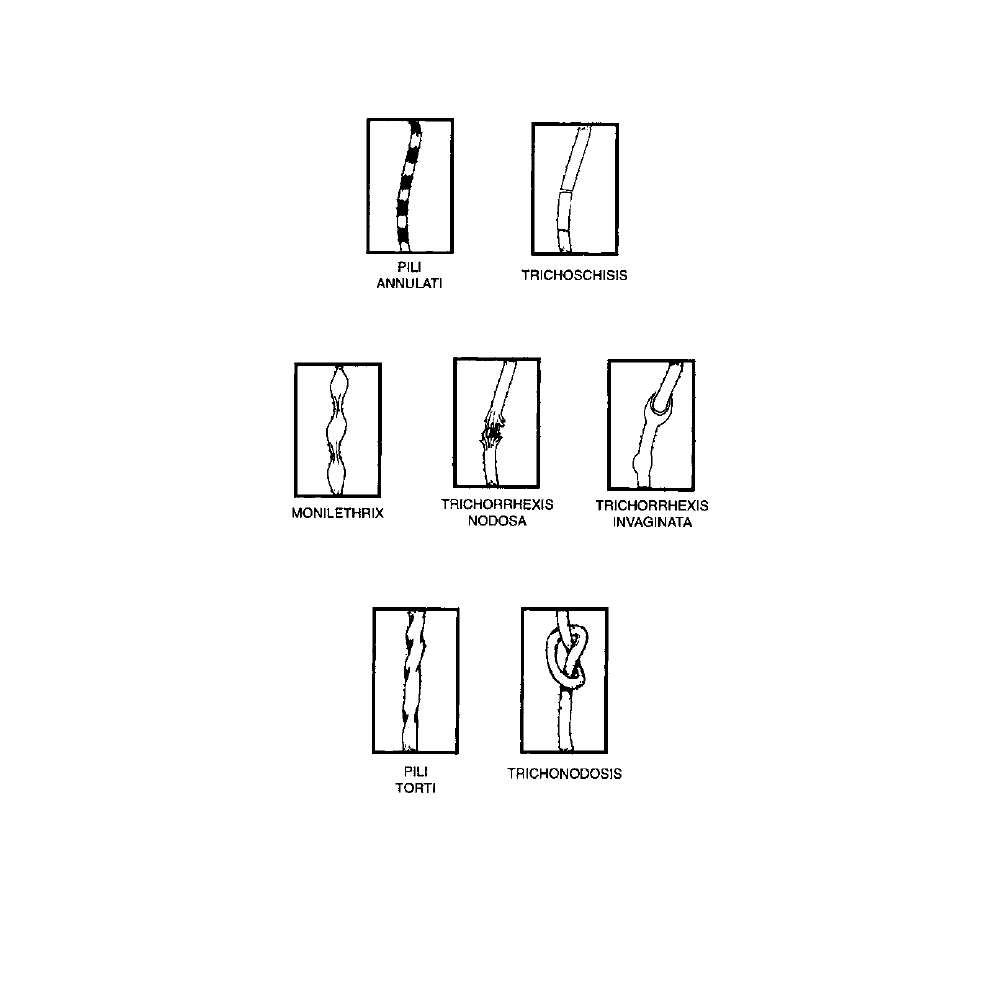
©1999 CRC Press LLC
Figure 5.21.1
Drawings of hair diseases and disorders. (Adapted from Figures
8, 13, and 18, Whiting, D. A., Structural abnormalities of the hair shaft,
J. Am.
Acad. Dermatol.,
16(1), 1987, with permission.)

©1999 CRC Press LLC
5.21.3 Trichoschisis (see
Figure 5.21.1
)
Trichoschisis is a clean, transverse fracture across the hair shaft through
cuticle and cortex and is associated with a localized absence of cuticle cells.
21
5.21.4 Pili Annulati (see
Figure 5.21.1
)
Pili Annulati, also called ringed hair, has characteristic alternating light and
dark bands in the hair shaft when viewed with transmitted light. The colors
of the bands are reversed when viewed with reflected light.
22
5.21.5 Monilethrix (see
Figure 5.21.1
)
Monilethrix is a condition in which the hair shaft has characteristic elliptic
nodes, 0.7 to 1 mm apart, with intervening tapered constrictions that are
nonmedullated.
23
The hair shaft is not twisted between the evenly spaced
nodes.
5.21.6 Pili Torti (see
Figure 5.21.1
)
In Pili Torti, the hair shaft is flattened and twisted through 180 degrees on
its axis. Typically, four or five twists are found at irregular intervals along the
hair shaft, giving it a beaded appearance.
24
5.21.7 Trichonodosis (see
Figure 5.21.1
)
Trichonodosis consists of knotting of the hair shaft. The condition is uncom-
mon and is found mostly in the short, curly hair of African heritage individ-
uals or in European heritage individuals with short, curly hair.
25
5.21.8 Cartilage Hair Hypoplasia
Cartilage Hair Hypoplasia is a condition of the hair found in certain forms
of dwarfism. The hairs are fine, light colored, and sparse but do not differ
from normal hair with the exception that their diameter is reduced.
26
This
condition is not illustrated.
5.22 Miscellaneous Characteristics
Those miscellaneous characteristics listed in Chapter 3 are Double Medulla,
Streaky Medulla, Gapping Pigment, Debris Present, Trailing Ovoid Bodies,
and Other. The term Other is added to the list to allow the examiner to score

©1999 CRC Press LLC
a miscellaneous characteristic not specifically listed here.
Figures 5.22.1
and
5.22.2
depict head hairs with Double Medullas.
Figure 5.22.3
illustrates a
beard hair with a Streaky Medulla.
Figure 5.22.4
portrays a hair with Gapping
Pigment.
Figure 5.22.5
illustrates a hair with Trailing Ovoid Bodies.
Figures
5.22.6
,
5.22.7
, and
5.22.8
depict some of the variations seen in beard hair.
Figure 5.22.9
illustrates a head hair with a Streaky Medulla. There is no figure
that represents a hair with Debris.
5.23 Insect, Arachnid, and Fungal Presence and Damage
Figure 5.23.1
illustrates a hair shaft with a louse egg attached.
Figure 5.23.2
depicts a hair shaft with insect/arachnid damage.
Figure 5.23.3
depicts a hair
shaft with fungal damage.
Figure 5.23.4
depicts a putrid hair root (a root
exposed to bacterial degradation) from a decomposing skull.
5.24 Cross-Sectional Shape
The variates for cross-sectional shape include Round, Oval, Triangular, Flat,
Kidney, and Shouldered. Photographic archetypes are presented that repre-
sent each cross-sectional shape.
Figure 5.24.1
illustrates a Round cross-sec-
tional shape.
Figure 5.24.2
illustrates an Oval cross-sectional shape.
Figure
5.24.3
illustrates a Triangular cross-sectional shape.
Figure 5.24.4
illustrates
a Flat cross-sectional shape. There is no figure for a Kidney cross-sectional
shape.
Figures 5.24.5
and
5.24.6
illustrate Shouldered cross-sectional shapes.
5.25 Cross-Sectional Pigment Distribution
The variates for cross-sectional pigment distribution include Uniform,
Peripheral, Central, and One-sided. Photographic archetypes are presented
that illustrate each cross-sectional pigment distribution.
Figure 5.25.1
illus-
trates a hair with Uniform cross-sectional pigment distribution.
Figure 5.25.2
illustrates a hair with Peripheral cross-sectional pigment distribution.
Figure
5.25.3
illustrates a hair with Central cross-sectional pigment distribution.
Figure 5.25.4
illustrates a hair with One-sided cross-sectional pigment dis-
tribution.

©1999 CRC Press LLC
Human Hair Types
6.1 The Human Hair Type
A human hair type, as defined in Chapter 1, is the specific combination of
certain genetically controlled macroscopic and microscopic characteristic
variates observed in that hair. The macroscopic and microscopic character-
istics that constitute the hair type are listed in
Table 6.1
. Characteristics A
and B are from
Table 2.1
. The remaining characteristics are taken from
Table
3.1
. These are the characteristics that are the phenotypic expression of the
individual's genotypes for hair production. Some of the characteristics
included in
Table 6.1
can be altered as a result of hair treatment or environ-
mental exposure. Before the hair type of a subject hair is determined, char-
acteristics such as color, degree of curl, outer cuticle profile, and pigment
density should be evaluated to determine whether those characteristics are
in their natural state. Characteristics that are not genetically related and
known to be associated with hair treatments or environmental exposure (e.g.,
damage to cuticle) are not listed as components of hair type. The character-
istics that define hair type are listed in
Table 6.1
, with an alphabetic prefix
for each characteristic so that when the characteristic variate scores that
identify the hair type are depicted as an ordered series, each of the variates
is preceded by its alphabetic identifier. These alphabetic identifiers are also
indicated in
Table 2.1
and
Table 3.1
for the users’ reference. The alphabetic
prefix facilitates checking to make sure that each of the characteristics is
represented in the ordered series of variates for each hair scored.
As an illustration of the use of
Table 2.1
,
Table 3.1
, and
Table 6.1
for the
purpose of scoring, the hair type of a subject hair is listed below. A hair that
is (A) wavy (02), with a (B) degree of curl of a circle with a diameter between
5 and 10 cm (04), is (D) Medium to Dark Brown (23), has (E) pigment
6

©1999 CRC Press LLC
density of Light to Medium (02), has (F) Coarse pigment granule size (02),
has (G) Uniform pigment distribution (01), has (H) Absent pigment aggre-
gation (00), has (I) Absent pigment aggregate size (00), has (J) a Continuous
medulla (01), has (K) an Opaque medulla (01), has (L) a Thin cuticle (01),
has (M) an Indistinct inner cuticle margin (01), a (N) Smooth outer cuticle
scale profile (01), has (P) No pigment in the cuticle (01), is (Q) Absent of
cortical texture (00), has (R) Rare cortical fusi (02), is (S) Absent of ovoid
bodies, (00) and a (V) Medium maximum shaft diameter (02) would have
the following alphanumerical array for describing its hair type:
A02-B04-D23-E02-F02-G01-H00-I00-J01-
K01-L01-M01-N01-P01-Q00-R02-S00-V02
The use of this scoring system may be extended to document not only
those genetically controlled characteristics that define hair type but also the
combination of all the characteristics presented in this atlas. Using the scoring
system to document all characteristics may be useful to the hair examiner
when performing a forensic hair comparison.
6.2 Regional Human Hair Characteristic Variates
The older terms “Mongoloid,” “Caucasoid,” and “Negroid” used to describe
the major population groups of humankind are replaced in this atlas with the
more modern terms East Asian, European, and African (meaning sub-Saharan
African), respectively. These terms were adapted from Brace.
27
The populations
of the Indian subcontinent are allied with the European populations in terms
Table 6.1 Hair Type Characteristic Varieties
a
A.
Hair Form
B.
Degree of Curl
D.
Color
E.
Pigment Density
F.
Pigment Granule Size
G.
Pigment Distribution
H
Pigment Aggregate Shape
I.
Pigment Aggregate Size
J.
Medulla Continuity
K.
Medulla Opacity
L.
Cuticle Thickness
M.
Inner Cuticle Margin
N.
Outer Cuticle Profile
P.
Pigment in Cuticle
Q.
Cortical Texture
R.
Cortical Fusi
S.
Ovoid Bodies
V.
Maximum Shaft Diameter
Note:
The characteristics and the alpha prefixes listed in the table were taken
from Table 2.1 and Table 3.1. Those letters that are not included in this
list are alpha prefixes which have been assigned to other characteristics.
a
Table 6.1 adapted from Table 3, Ogle, R. R., Jr., Individualization of human
hair: the role of the hair atlas,
Microscope
, 46(1), 19, 1998. With permission.

©1999 CRC Press LLC
of anthropological kinship.
28
However, the scalp hair of the Indian subcontinent
populations is more closely allied with the hair type of the East Asian popula-
tions, as is the scalp hair of the native populations of North, Central, and South
America. Although the native populations of the Americas are allied with the
East Asians anthropologically, many of the populations of Mexico and the other
countries of Central and South America are of mixed heritage, so the scalp hair
of these populations may represent characteristics consistent with those of a
mixed heritage.
Forensic anthropologists rely primarily on skeletal analysis for an accu-
rate estimate of original geographic origins. The depth of skin pigmentation
has considerable overlap between individuals of African, European, and East
Asian geographical origin, as does hair form among individuals of European,
African and East Asian populations. Hair color, form, and degree of curl,
however, can provide an indication of the geographical ancestry of the indi-
vidual from whom a questioned hair originated. Those indications of the
geographical heritage of an individual who is the source of a questioned hair
can be of considerable value in the forensic examination of human hair,
particularly with regard to providing investigative leads as to the possible
regional ancestry of the individual from whom a questioned hair originated.
6.2.1 Regional Shaft Diameter
The diameter for African ancestry hair is smaller than that for the other two
groups,
29
but note that these highly curled hairs will lie on their side oriented
with the smaller diameter of the flattened cross-section of the hair facing
upward. That orientation will necessarily show the smaller of the two diam-
eters in the view of the longitudinal mount. The regional hair shaft diameter
for East Asian ancestry individuals is thicker than those of the other two
regional groups. The hair shaft diameter for European region heritage indi-
viduals is intermediate between the African heritage and East Asian heritage
groups, but it has considerable overlap with both of these groups.
30
Further
studies involving the consistent measurement of the maximum shaft diameter
(the maximum cross-sectional shape) of hairs with known ancestry may be
valuable in better establishing the relationship between maximum shaft
diameter and regional ancestry.
6.2.2 Regional Cross-Sectional Shape
The cross-sectional shape for the African heritage hair is flattened or ribbon
shape, nearly round in the East Asian heritage hair, and varies widely in
European heritage hair, from the flattened shape seen in the African hair to
the near round shape of the East Asian hair.

©1999 CRC Press LLC
6.2.3 Regional Pigmentation
The pigmentation pattern for African heritage hair is dense and clumped,
whereas the pattern for East Asian heritage hair is dense but normally does
not show the clumping seen in African heritage hair.
31
European heritage
hair ranges from very light density to very heavy density, and it overlaps
considerably the other two groups. The pigment aggregation in European
hairs is usually limited to streaky aggregates without the clumping seen in
the African hair type.
6.2.4 Regional Cuticle Thickness
African heritage hair normally has a thin cuticle, while Asian hair usually has
a thick, prominent cuticle. European hair varies widely and overlaps com-
pletely the cuticle thickness of the African heritage and the East Asian heritage
hair forms. The cuticle of the European heritage hair can vary from an
invisible cuticle to the thickness seen in East Asian heritage hairs.
6.2.5 Hair Form
Hair form is diagnostic for African heritage hair,
32
since the high degree of
curl seen in the African heritage hair is rare in European heritage hair and
largely unknown in East Asian heritage populations. But it is also present in
some other populations, e.g. Papua New Guinea native populations. The hair
form for East Asian heritage populations is uniformly straight, but note that
many populations allied with the East Asian heritage groups may have hair
that can be quite curly. The European heritage hair form varies widely, from
a curl near that of the African heritage groups to the straight hair seen in the
East Asian heritage groups. Further research is needed from the forensic
community to characterize the hair forms of the many populations through-
out the Pacific islands and other world populations so that the hair form of
those populations may be added to future editions of this or other atlases.
6.3 Regional Pubic Hair Characteristics
The pubic hair form is also related to the regional origin heritage of the
individual. Individuals with East Asian heritage have pubic hair that is typ-
ically black and wavy. Individuals with African heritage have highly curled
pubic hair, with a form near that of the scalp hair. The pubic hair of African
heritage individuals is typically black in color but may have other colors
owing to admixture with individuals of European descent. Individuals with
European heritage have pubic hair with a wide variation in form that may
be curly and convoluted but lacks the wavy form seen in East Asian pubic
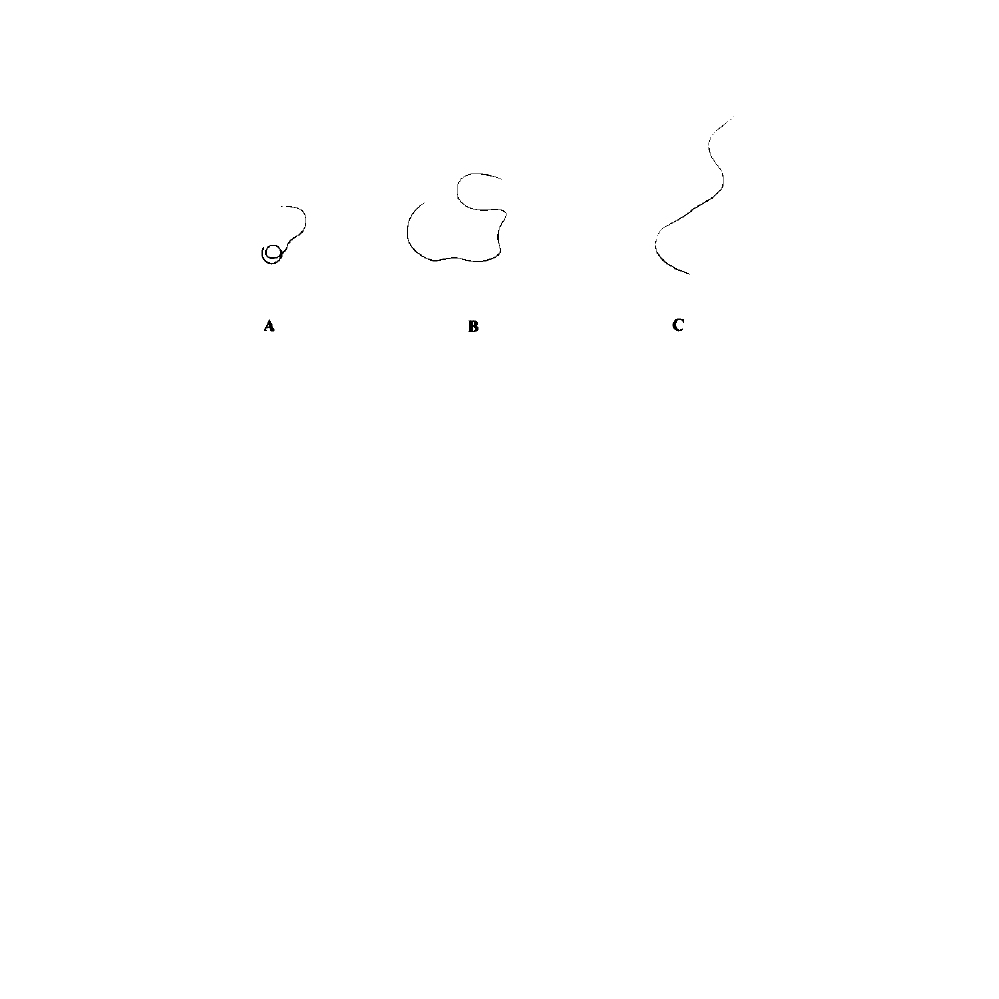
©1999 CRC Press LLC
hair or the high degree of curl seen in the African pubic hair. The color of
European heritage individuals’ pubic hair ranges widely and is correlated
with the scalp hair color.
Figure 6.1
illustrates the typical hair form for African
heritage pubic hair (A), the typical hair form for European pubic hair (B),
and the typical hair form for East Asian pubic hair (C).
Figure 6.1
Pubic hairs from (A) individual of African heritage, (B) individual of
European heritage, and (C) individual of East Asian heritage.

©1999 CRC Press LLC
References
1. Shaffer, S., A protocol for the examination of hair evidence,
Microscope,
30,
1982.
2. Ogle, R. R., Jr., Individualization of human hair: the role of the hair atlas,
Microscope,
46(1), 17, 1998.
3. Ogle, Ibid.
4. Greenwell, M. D., Willmer, A., and Kirk, P. L., Human hair studies: III.
Refractive index of crown hair,
J. Crim. Law Criminol.,
31, 1941.
5. Bailey, J. and Schliebe, S., The precision of the average curvature measurement
in human head hairs,
Proceedings of the
Symposium on Forensic Hair Com-
parisons
, FBI, U.S. Government Printing Office, Washington, D.C., 1985.
6. Dawber, R. and Van Neste, D.,
Hair and Scalp Disorders,
Martin Dunitz,
London, 1995, 19, (J. B. Lippincott Co., Philadelphia, 1995).
7. Bisbing, R. E., The forensic identification and association of human hair, in
Forensic Science Handbook
, Saferstein, R., Ed., Prentice-Hall, Inc., Englewood
Cliffs, NJ, 1982.
8. Barnicot, N. A., Birbeck, M. S. C., and Cuckow, F. W., The electron micros-
copy of human hair pigments,
Ann. Hum. Genet.,
19, 31, 1955.
9. Cesarini, J. P., Hair melanin and hair color, in
Hair and Hair Diseases
,
Orfanos, C. E. and Happle, R., Eds., Springer-Verlag, New York, 1990, Chap. 8.
10. Barnicot, Ibid.
11. Hicks, J. W.,
Microscopy of Hairs: A Practical Guide and Manual
, FBI, U. S.
Government Printing Office, Washington, D.C., 1977.
12. Ogle, R. R., Jr. and Mitosinka, G. A., A rapid method of preparing hair
cuticular scale casts,
J. For. Sci.
, 1973.
13. Hicks, Ibid.
14. Hausman, L. A., The cortical fusi in mammalian hair shafts,
Am. Nat.,
66,
1932.
15. Petraco, N., Fraas, C., Callery, F. X., and DeForest, P. R., The morphological
and evidential significance of human hair roots,
J. For. Sci.,
33, 1988.

©1999 CRC Press LLC
16. Linch, C. A., Smith, S. L., and Prahlow, J. A., Evaluation of the human hair
root for DNA typing subsequent to microscopic comparison,
J. For. Sci.,
43(2), 305, 1998.
17. Fong, W. and Inami, S. H., Simple rapid and unique hand techniques for
cross-sectioning fibers and hair,
J. For. Sci.,
33, 1988.
18. Dawber, Ibid.
19. Whiting, D. A., Structural abnormalities of the hair shaft,
J. Am. Acad. Der-
matol.,
16, 1, 1987.
20. Whiting, Ibid.
21. Whiting, Ibid.
22. Whiting, Ibid.
23. Whiting, Ibid.
24. Whiting, Ibid.
25. Dawber, R. P. R., Knotting of scalp hair,
Br. J. Dermatol.
, 91, 169, 1974, as
quoted in Whiting, Ibid.
26. Happle, R., Genetic defects involving the hair, in
Hair and Diseases
, Orfanos,
C. E. and Happle, R., Eds., Springer-Verlag, Berlin, 1990, chap. 14.
27. Brace, C. L., Region does not mean “Race”—reality vs. convention in forensic
anthropology,
J. For. Sci.,
40(2), 171, 1995.
28. Brace, Ibid.
29. Bisbing, Ibid.
30. Brues, A. M.,
People and Races,
Macmillan Publishing, Co., New York, 1977.

©1999 CRC Press LLC
Glossary
Aberration (Shaft)
An abnormal or unusual condition of the hair shaft due
to a genetic disorder, disease or environmental damage.
Aggregation (Pigment)
The appearance of the pigment granules when they
are concentrated in a mass that has a recognizable form.
Amorphous
Literally, “without form”; a form that does not fit into a category
of a defined form pattern.
Anagen
The active growth phase of a hair root in the hair growth cycle. The
root of an anagen hair is elongated, is covered with a root sheath, and is fully
pigmented.
Archetype
A model against which other similar objects can be compared to
establish degrees of similarity or dissimilarity.
Artifacts
Features that are the result of damage, optical distortion, or other
factors; not a true feature.
Attribute
Synonym for characteristic.
Buckling
A disruption of the hair shaft demonstrating itself as an abrupt
change in direction with or without a slight twist. This feature may be due
to genetic factors, or it may result from damage (i.e., hair treatments).
Catagen
The transitional phase of the hair root from the active growth phase
(anagen) to the resting growth phase (telogen) in the hair growth cycle. The
root of a catagen hair may have a club-shaped root, a sparse amount of
pigment, and a dried up root sheath.
Categorize
Identify the variate class to which a hair characteristic belongs;
scoring of a study hair through use of the archetypes in this atlas.
Characteristic
A microscopic or macroscopic feature, attribute, or trait of a
hair.
Characterize
The process of examining and describing the characteristics of
a hair or a set of hairs.

©1999 CRC Press LLC
Class
A category of hair (e.g., scalp hair, dog hair) or a group of hairs defined
by the presence in each hair of all the class characteristics that define the
class, e.g., an East Asian heritage hair type.
Class Characteristic
A characteristic shared by all members of a class. It may
vary in some way from one member to the next (e.g., size, shape, color,
position) but is present in each member of the class. When variation is
present, the characteristic may be used as part of
a set of other class charac-
teristics
also exhibiting some variation to establish
a set of characteristics
of
which
the aggregate constitutes a unique set of characteristic variates
that
may allow for individualization of the object bearing those characteristics.
Club Hair
A hair which has a root that is surrounded by a bulbous enlarge-
ment composed of completely keratinized cells, preliminary to normal loss
of the hair from the follicle; Telogen hair.
Color
The hue of the hair as judged either macroscopically or micro-
scopically.
Comparative Analysis
The most common type of analysis in forensic exam-
inations in which a questioned object (questioned source) is compared to a
known (an object of known source) for the purpose of determining if the
questioned and known objects have the same source, as opposed to the
comparison to an archetype in which the purpose is to classify the hair
characteristic variate under consideration (determine the variate class to
which the hair characteristic variate belongs).
Continuous Variation
Variation where the difference between one charac-
teristic variate and its closest neighbor in terms of similarity is virtually
indiscernible. Example: A particular shade of brown hair is indistinguishable
from the shade of a brown hair slightly darker or lighter, since the number
of shades of brown hair is very large and the eye’s ability to distinguish shades
is limited.
Convoluting
Rotation or twisting of the hair shaft, which can occur naturally
or as a result of mechanical force. The hair shaft of a convoluted hair may
loop or twine upon itself.
Cortex
The major portion of the hair shaft, between the cuticle and the
medulla, composed of elongated and fusiform cells.
Cortical Fusi
Small, fusiform bodies within the hair shaft cortex that have
the appearance of empty membranes; they may be filled with air or liquid.
Crenate
Having a rounded or scalloped margin, as is said of the distal edge
of hair scales.

©1999 CRC Press LLC
Cross-section
A thin section of the hair shaft cut at right angles to the
longitudinal axis.
Curl
The degree of curvature of a hair along its long axis; curliness.
Cuticle
The covering of the hair shaft, composed of overlapping scales.
Density (Pigment)
The relative abundance of pigment granules in the hair
cortex, as judged by their microscopic appearance.
Discontinuous Variation
Each variate of a characteristic has a recognizable
form that is different from the other variates; i.e., each variate differs
qual-
itatively
from the others (cf.
Continuous Variation
).
Distribution (Pigment)
The distribution pattern of the pigment granules
about the central axis of the hair shaft (Uniform, Peripheral, One-sided,
Random, or Central).
Exemplar
Synonym for known (an item of known source) or a representative
sample taken from the known for comparison to a Questioned item.
Feature
Synonym for characteristic.
Fusi
The spindle-shaped air or fluid-filled bodies found in some hair shafts
or their flattened bodies, which have lost the air or fluid with which they
were filled (also called cortical fusi).
Fusiform
Tapering at each end; spindle-shaped.
Hair Form
The spacial configuration of a hair with respect to curliness.
Hair Type
The specific combination of genetically controlled macroscopic
and microscopic characteristic variates observed in a particular hair.
Identification
The process of identifying the class to which an object belongs;
in some forensic disciplines, it is used in the same sense as individualization
(e.g., fingerprints, firearms).
Imbricate
Having the edges overlapping in a regular pattern.
Individualization
The identification of the unique source of an object. With
respect to a questioned hair, identification of the individual from whom the
hair originated. The individualization of human hair is rarely achievable
using microscopy techniques.
Keratin
Any of various sulphur-containing fibrous proteins that form the
chemical basis for keratinized epidermal tissues such as hair, nails, feathers,
and horns of animals.

©1999 CRC Press LLC
Known
Term used to designate an item or object with a known source; used
as a comparison standard.
Lice
(Plural of louse) Parasitic insects. Those found on man include head
lice (
Pediculus humanus capitis
), body or clothing lice (
Pediculus humanus
corporis
), and crab lice (
Phthirus pubis
), which live in the pubic region,
eyelashes, or eyebrows. The eggs of the lice may be seen attached to the hair
shaft.
Limited Range
A term coined by hair examiners to designate the smaller
range of a variate seen in the hair from an individual as opposed to the wider
range of the variate in the human population.
Longitudinal Plane
Parallel to the long axis of the hair.
Looped
A condition in which the distal edges of the cuticle scales are curved
inward so that they curve or cup toward the edge of the hair shaft. Looped
scales can trap air below the curved portion, giving the appearance of dark
bands between the scale and the shaft.
Macroscopic
Large enough to be perceived without magnification.
Magnification Levels
(As applied to human hair examinations) Macroscopic
— Observed with the unaided eye (also referred to as “gross”); stereoscopic
(low-power) — Observed with the stereoscopic microscope (usually 3
¥
to
70
¥
magnification), but may be slightly higher or lower; high power —
Compound microscope that may be 20
¥
to 1000
¥
magnification; scanning
electron microscope — From compound light microscope magnification up
to 250,000
¥
magnification.
Medulla
The central canal of cells of the hair shaft, which may appear black
(air-filled cells) or translucent (fluid-filled cells). Pronounced either “mah-
doo’-lah” or “meh-dull’-ah” as a personal preference.
Medulla Continuity
The continuous or discontinuous nature of the opaque
or translucent medulla from the proximal end to the distal end of the hair
shaft.
Medulla Opacity
The appearance of the medulla as being either opaque or
translucent when viewed with transmitted light in the compound light
microscope.
Melanin
Brown pigments occurring in plants and animals; the pigment in
human hair that provides the brown to black color of the hair.
Microscopic
Too small to be perceived by the unaided eye but large enough
to be studied under a microscope; examination under the microscope (same
as microscopical).

©1999 CRC Press LLC
Monilethrix
A hair disorder that results in periodic nodes along the length
of the hair with intervening, tapering constrictions that are not medullated.
Ovoid Bodies
Oval-shaped pigmented bodies in the hair cortex.
Papilla
A small projection at the base of the hair follicle composed of con-
nective tissue.
Parfocal
A microscope objective system designed to have similar focal dis-
tances so that when the objective turret is rotated to another objective, the
object in view remains in focus.
Pili Annulati
A hair disorder that results in ringed or banded hair; alternating
bright and dark bands in the hair shaft.
Pili Torti
A hair disorder demonstrated by a hair that is flattened and twisted
through 180 degrees on its axis. It is found at irregular intervals along the
shaft.
Planes
Longitudinal — Plane parallel to the long axis of the hair; Transverse
— Plane parallel to the short axis of the hair.
Questioned
In forensic science, an item or object that has a questioned or
unknown source.
Range Limits
The upper and lower limits that describe the variation of a
hair characteristic within a single hair, within the hairs of an individual’s
scalp, within the hairs of an unknown specimen, or within a given population
of individuals.
Reference Standard
A hair standard in a reference collection to be used as a
comparison standard in hair research.
Regions of the hair:
Proximal
— Area nearest the hair root.
Distal
— Area farthest from the hair root.
Medial
— Area between the proximal and distal areas of the hair shaft.
Note: These terms refer to the areas of a hair shaft as it exists, since cutting
the hair results in a shift of the distal area.
Scales
The keratinized scale-like covering of the hair; cuticle.
Serrate
Having the appearance of the teeth of a saw; jagged.
Shade
Degree of darkness of a color.

©1999 CRC Press LLC
Spectrum
The range of values exhibited collectively by all the individuals in
a population with regard to a specific characteristic; the range of the variates
of a hair characteristic in a population.
Telogen
The end phase of the hair growth cycle during which the hair root
becomes a club root and the hair eventually falls out of the follicle. The root
of a telogen hair is club-shaped, with little or no adhering root sheath, and
lacks pigment.
Translucent
Transmitting light but causing sufficient diffusion to allow the
perception of an image, as is said of the appearance of a medulla that has
cells that are fluid-filled rather than air-filled.
Transverse Plane
Parallel to the short axis of the hair; plane perpendicular
to the long axis of the hair.
Tricho
A prefix denoting relationship to hair.
Trichochromogenic
Giving color to the hair.
Trichoclasis
“Greenstick” fracture of the hair shaft. A transverse fracture of
the shaft, which is splinted partly or wholly by intact cuticle.
Trichology
The sum of what is known regarding the hair; the study of hair.
Trichonodosis
A condition characterized by apparent or actual knotting of
the hair. It is uncommon but not rare in some individuals of African ancestry
or others with tightly curled hair.
Trichoptilosis
A longitudinal splitting or fraying of the hair shaft. It com-
monly occurs at the distal end and is often referred to as “split ends.”
Trichorrhexis
A condition in which the hair breaks off.
Trichorrhexis Invaginata
A hair disorder in which the hair has indented and
the shaft has folded into itself, having the appearance of a ball and socket;
“Bamboo hair.”
Trichorrhexis Nodosa
A condition that appears along the hair shaft as small,
beaded swellings associated with a loss of cuticle. The expanded areas are
composed of frayed cortical fibers through which the hair readily fractures.
Trichoschisis
A clean, transverse fracture across the hair shaft through cuticle
and cortex, as is associated with a localized absence of cuticle cells.
Trichosiderin
Formerly, an iron-containing pigment found in normal
human red hair. It is now thought to be fragments of the pigment phaeomel-
anin.

©1999 CRC Press LLC
Undullating
Macroscopic — A smooth wave-like hair form (as opposed to
the abrupt form of hair buckling). Microscopic — Refers to a wavy form
seen microscopically which is accompanied with true variations in hair shaft
diameter.
Variate
The descriptor for any of the various forms of each macroscopic or
microscopic characteristic observed in human hair. The variate may be con-
tinuous, discontinuous, or a measured value.
Variate Class Limit
The upper or lower limit of a continuous variate class.
For variates with two classes, the upper limit of the lower class and the lower
limit of the upper class is the same, i.e., divides the population of continuous
variates into two classes.
Vellus
Fine body hair that is present only until puberty.
Weathering
The effect of the environment on the hair shaft; wear and tear
that causes damage to the cuticle and cortex.

©1999 CRC Press LLC
Bibliography
Achekan, Wv., Determination of agglutinogens of the ABO blood group system in
hair,
Suedebeno-Med Ekspertiza SSSR
, 6, 1963.
Aitken, C. G. G. and J. Robertson, The value of microscopic features in the exam-
ination of human head hairs, I: Statistical analysis,
J. For. Sci.,
31, 1986.
Aitken, C. G. G. and J. Robertson, A contribution to the discussion of probabilities
and human hair comparisons,
J. For. Sci.,
32, 1987.
Anderson, H. P., A simple scheme for the individualization of human hair,
Micro-
scope,
17, 1969.
Andrew, R. L., Fluorescence of human hair,
J. Crim. Law Criminol.
, 27, 1937.
Anon., Hair as a “detective”,
Lit. Dig.
, 73(1), 25, 1922.
Appleyard, H. M.,
Guide to the Identification of Animal Fibres,
2nd ed., Wool Indus-
tries Research Association, Leeds, U.K., 1978.
Baden, H. P., L. D. Lee, and J. Kubilis, A genetic electrophoretic variant of human
hair alpha polypeptides,
Am. J. Hum. Genetics
, 27, 1975.
Bailey, J., The value of average curvature measurements in human pubic hair com-
parisons. Paper presented at the International Association of Forensic Science
meeting, Adelaide, So. Australia, 1990.
Bailey, J. and S. Schliebe, The precision of the average curvature measurement in
human head hairs,
Proceedings of the International Symposium on Forensic Hair
Comparisons
, FBI, U.S. Government Printing Office, Washington, D.C., 1985.
Banerjee, A. R., On variation of human hair: hair form and medullation,
Z. Morph.
Anthrop.,
57, 1965.
Banerjee, A. R. and A. B. Das Chaudhuri, Genetics of medullary structure of human
head hair,
Man in India,
49, 1969.
Barman, J. M., I. Astore, and V. Pecoraro, The normal trichogram of the adult,
J.
Invest. Dermat.
, 44(4), 1963.
Barna, C. E. and S. F. Stoeffler, A new method for cross-sectioning single fibers,
J.
For. Sci.,
32, 1987.
Barnett, P. D. and R. R. Ogle, Probabilities and human hair comparison,
J. For. Sci.
,
27, 1982.

©1999 CRC Press LLC
Barnicot, N. A., The relationship of the pigment trichosiderin to hair color,
Ann.
Hum. Genet.
, 21, 1956–57.
Barnicot, N. A., M. S. C. Birbeck, and F. W. Cuckow, The electron microscopy of
human hair pigments,
Ann. Hum. Genet.
, 19, 31, 1955.
Bassett, William A. G., Sex determination by sex chromatin identification in the hair
root sheath,
J. Can. Soc. For. Sci.
, 11(3), 1978.
Beeman, J., The scale count of human hair,
J. Crim. Law Criminol.
, 32, 1942.
Beeman, J., Further evaluation of the scale count of human hair,
J. Crim. Law
Criminol.
, 33, 1943.
Bellamy, R., Measuring hair colour,
Am. J. Phys. Anthro.
, 14, 1930.
Berg, S., Identification value of the human hair,
Arch. fur Kriminol.
, 159, 1977.
Birbeck, M. S. C., E. H. Mercer, and N. A. Barnicot, The structure and formation of
pigment granules in human hair,
Exp. Cell Res.
, 2, 1956.
Bisbing, R. E., The forensic identification and association of human hair, in
Forensic
Science Handbook
, Saferstein, R., Ed., Prentice-Hall, Inc., Englewood Cliffs, NJ,
1982.
Bisbing, R. E. and M. F. Wolner, Microscopical discrimination of twins’ head hair,
J. For. Sci.
, 29, 1984.
Boas, J. and N. Michelson, Graying of hair,
Am. J. Phys. Anthro.
, 17, 1932.
Bolliger, A., Non-keratinous constituents of hair,
Med. J. of Australia
, 2, 1949.
Bolognia, K. and S. Pawlek, Hair Color, in
Dermatology in General Medicine
, 3rd
ed., Fitzpatrick, T. B., et al., Eds., McGraw-Hill, New York, 1988.
Bottoms, E., E. Wyatt, and S. Comaish, Progressive changes in cuticle pattern along
the shafts of human hair as seen by the scanning electron microscope,
Brit. J.
Derm.
, 86, 1972.
Bradbury, J. H., The structure and chemistry of keratin fibers,
Adv. Prot. Chem.
, 27,
111, 1973.
Brown, A. C., R. J. Gerdes, and J. Johnson, Scanning electron microscopy and electron
probe analysis of congenital hair defects, Proceedings of the 4th Annual Scanning
Electron Microscope Symposium, O. Johari, Ed., Chicago, 1971.
Brown, A. C., Ed.,
The First Human Hair Symposium
, Medcom Press, New York, 1974.
Brown, A. C., Hair breakage: the scanning electron microscope as a diagnostic tool,
J. Soc. Cosmet. Chem.
, 26, 1975.
Brown, F. M., The microscopy of mammalian hair for anthropologists,
Proceedings
of the American Philosophical Society
, 85, 1942.
Brunner, H. and B. J. Coman,
The Identification of Mammalian Hair
, Inkata Press,
Melbourne, 1974.
Caputo, R. and B. Ceccarelli, Study of normal hair and some malformations with a
scanning electron microscope,
Arch. Klin. Exp. Derm.,
234, 1969.

©1999 CRC Press LLC
Carracedo, A., et al., The isoelectric focusing of keratins in hair followed by silver
staining,
For. Sci. Intl.
, 29, 1985.
Carracedo, A., et al., Isoelectric focusing patterns of some mammalian keratins,
J.
For. Sci.,
32(1), 1986.
Choudhry, M. Y., et al., Individual characteristics of chemically modified human
hairs revealed by scanning electron microscopy,
J. For. Sci.
, 28, 1983.
Cook, R. and D. Norton, An evaluation of mounting media for use in forensic textile
examination.
J. For. Sci. Soc.
, 22, 1982.
Cornelis, R. and A. Speecke, Neutron activation analysis of human hair collected at
regular intervals for 25 years,
J. For. Sci. Soc.
, 11, 1971.
Cornelis, R., Is it possible to identify individuals by neutron activation of hair? —
failure of a mission,
Med. Sci. Law
, 12, 1972.
Cottingham, E., R. Kissinger, and W. Tolgyesi, Observations on the female scalp hair
population, distribution and diameter,
J. Soc. Cosmet. Chem.
, 28, 1977.
Culbertson, J. C., N. A. Breslau, M. K. Moore, and E. Engel, Sex chromatin deter-
mination from hair,
J.A.M.A.,
207, 1969.
Curry, A. S. and C. A. Pounds, Arsenic in hair,
J. For. Sci. Soc.
, 17, 1977.
Curtis, R. K. and D. R. Tyson, Birefringence: polarization microscopy as a quanti-
tative technique of human hair analysis,
J. Soc. Cosmet. Chem.
, 27, 1976.
Daker, M. G., Chromosomes from hairs,
Lancet
, 1970.
Danforth, C. H., The hair,
Nat. His.
, 26, 1925.
Das-Chaudhuri, A. B., Genetic basis of hair medulla by twin study,
Am. J. Phys.
Anthro.
, 44, 1976.
Das-Chaudhuri, A. B., A twin study of the structure of human hair medulla,
Hum.
Hered.
, 26, 1976.
Davis, B. K., Phases of the hair growth cycle,
Nature
, 194, 1962.
Dawber, R. and S. Comaish, Scanning electron microscopy of normal and abnormal
hair shafts,
Arch. Dermatol.
, 101, 316, 1970.
Dawber, R. and D. Van Neste,
Hair and Scalp Disorders
, Martin Dunitz, London and
J. B. Lippincott, Philadelphia, 1995.
Day, T. H., Interspecific variation in the hair proteins,
Comp. Biochem. Physio.
, 43,
1972.
De Forest, P. R., Individualization of human hair: pyrolysis-gas chromatography.
Doctoral Dissertation, Univ. of California, Berkeley, 1969.
De Forest, P. R. and P. L. Kirk, Forensic individualization of hair,
Criminoligist
, 8,
1973.
Deadman, H. A., Human hair comparison based on microscopic characteristics,
Proceedings of the International Symposium on Forensic Hair Comparisons,
U.S.
Government Printing Office,Washington, D.C., 1985.

©1999 CRC Press LLC
Dixon, A. D. and J. B. D. Toor, Sex chromatin as an aid to identification of sex in
forensic medicine,
Nature
, 178, 1956.
Duggins, O. H., The age changes in head hair from birth to maturity: IV. Refractive
indices and birefringence of the cuticle of hair of children,
Am. J. Phys. Anthro.
,
12, 1954.
Duggins, O. H. and M. Trotter, The age changes in head hair from birth to maturity,
II. Medullation in hair of children,
Am. J. Phys. Anthro.
, 8, 1950.
Duggins, O. H. and M. Trotter, Changes in morphology of hair during childhood,
Ann. NY Acad. Sci.
, 53, 1951.
Eddy, M. W., Hair classification,
Proc. Penn. Acad. Sci.
, 12, 1938.
Engel, E., J. C. Culbertson, R. W. Mahley, and G. M. Fenichel, Barr bodies studies
from the hair,
Lancet
, 1970.
Evans, W. E. D., Hair,
J. Forens. Med.
, 7, 1960.
Evans, W. E. D., The use of normal incident illumination in the examination of hair
cuticle,
J. For. Sci. Soc.
, 4, 1964.
Feinberg, H. S.,
All About Hair
, Simon and Schuster, New York, 1979.
Ferriman, D.,
Human Hair Growth in Health and Disease
, Charles C. Thomas, Spring-
field, IL, 1971.
Fiala, G. F., Preparation of hair for cross-section examination,
Am. J. Phys. Anthro.
,
14, 1930.
Fong, W. and S. H. Inami, Simple rapid and unique hand techniques for cross-
sectioning fibers and hair,
J. For. Sci.
, 33, 1988.
Fouweather, C. and J. Porter, An appraisal of human head hair as forensic evidence,
J. Soc. Cosmet. Chem.
, 26, 1975.
Frazer, R. D. B., Keratins,
Sci. Am.
, 221, 1969.
Frazer, R. D. B., T. P. MacRae, and G. E. Rogers,
Keratins — Their Composition,
Structure and Biosynthesis
, Charles C. Thomas, Springfield, IL, 1972.
Gamble, L. H. and P. L. Kirk, Human hair studies. II. Scale counts,
J. Crim. Law
Criminol.
, 31, 1941.
Gardner, B. B. and D. L. MacAdam, Colorimetric analysis of hair color,
Am. J. Phys.
Anthrop.
, 19(2), 1934.
Garn, S. M., Cross sections of undistorted human hair,
Science
, 105, 1947.
Garn, S. M., The examination of hair under the polarizing microscope,
Ann. NY
Acad. Sci.
, 53, 1951.
Garn, S. M., Types and distribution of hair in man,
Ann. NY Acad. Sci.
, p. 498, 1952.
Gaudette, B. D., Probabilities and human pubic hair comparisons,
J. For. Sci.
, 21(3),
1976.
Gaudette, B. D., Some further thoughts on probabilities and human hair compari-
sons,
J. For. Sci.
, 23(4), 1978.

©1999 CRC Press LLC
Gaudette, B. D., A supplementary discussion of probabilities and human hair com-
parisons,
J. For. Sci.
, 27(2), 1982.
Gaudette, B. D., Strong negative conclusions in hair comparison — a rare event,
Can. Soc. For. Sci. J.
, 18(1), 1985.
Gaudette, B. D. and A. A. Tessarolo, Secondary transfer of human scalp hair,
J. For.
Sci.
, 32(5), 1241, 1987.
Gaudette, B. D. and E. S. Keeping, An attempt at determining probabilities in human
scalp hair comparison,
J. For. Sci.
, 19(3), 1974.
Glaister, J.,
A Study of Hairs and Wools Belonging to the Mammalian Group of Animals
Including a Special Study of Human Hair, Considered from Medico-Legal Aspects
,
MISR Press, Cairo, 1931.
Glaister, J., Contact traces,
J. For. Med.
, 7, 1960.
Glaister, J., Hairs and fibers,
The Criminol.
, 4, 1969.
Glaister, J., Hair considered medicolegally,
Transactions Medico Legal Society
, 22, 1928.
Glaister, J. and S. Smith,
Recent Advances in Forensic Medicine
, P. Blakiston’s Sons &
Co., Philadelphia, 1931.
Goettcher, B. and D. J. Kay, ABO grouping of human hair using radioactively-labeled
antibodies,
Vox. Sang.
, 25, 1973.
Goin, L. J., W. H. McKee, and P. L. Kirk, Human hair studies: application of the
microdetermination of comparative density,
J. Crim. Law, Criminol. Pol. Sci.
, 43,
1952.
Greenwell, M. D., A. Willmer, and P. L. Kirk, Human hair studies. III. Refractive
index of crown hair,
J. Crim. Law Criminol.
, 31, 1941.
Gummer, C. L., R. P. R. Dawber, and J. A. Swift, Monilethrix: an electron microscopic
and electron histochemical study,
Br. J. Dermatol.
, 105, 529, 1981.
Guyenot, E., Heredity of red hair,
J. Genet. Hum.
, 3, 1954.
Gyoten, Y., Identification of human hair. II. Medullary index of hair,
Shikoku Acta
Med.
, 10, 1957.
Hamilton, J. B., Ed.,
Growth, Replacement and Types of Hair
, Vol. 53, N.Y. Academy
of Science, New York, 1951.
Hanna, B. L., Colorimetric estimation of the pigment concentration on hair of
various color grades,
Am. J. Phys. Anthro.
, 14, 1956.
Hardy, D. and H. P. Baden, Biochemical variation of hair keratins in man and non-
human primates,
Am. J. Phys. Anthro.
, 39, 1973.
Hardy, J. D., A practical laboratory method of making thin cross-sections of fibres,
Circular No. 378, U.S. Dept. of Agriculture, 1953.
Hardy, J. D. and T. M. Plitt, An improved method for revealing the surface structure
of fur fibers, USDI,
Fish Wildl. Serv. Cir.
, 7, 1940.
Harvey, L. A., The examination of hairs,
Pol. J.
, 11, 1938.

©1999 CRC Press LLC
Hausman, L. A., Mammal fur under the microscope,
Nat. Hist.
(
J. Am. Mus. Nat.
Hist.
), 20, 1920.
Hausman, L. A., Structural characteristics of the hair of mammals,
Am. Nat.
, 44, 1920.
Hausman, L. A., Identifying hairs used in textiles,
Haugh. Ind. Dig.
, 2, 1920.
Hausman, L. A., The microscopic identification of commercial fur hairs,
Sci. Mon.
,
10, 1920.
Hausman, L. A., A micrological investigation of the hair structure of the monotrem-
ata,
Am. Jour. Anat.
, 27, 1920.
Hausman, L. A., Hairs that make fabrics,
Sci. Amer.
, 122, 1920.
Hausman, L. A., Fabrics under the microscope,
Sci. Am.
, 125, 1921.
Hausman, L. A., Hair coloration in animals,
Sci. Mon.
, 12, 1921.
Hausman, L. A., Virgin wool and shoddy,
Sci. Am.
, 127, 1922.
Hausman, L. A., Human hair under the microscope: recent acquisitions to the knowl-
edge of its minute structure and their applications,
Sci. Am.
, 126, 1922.
Hausman, L. A., Further studies in the relationships of the structural characteristics
of mammalian hair,
Am. Nat.
, 58, 1924.
Hausman, L. A., A comparative racial study of the structural elements of human
head hair,
Am. J. Phys. Anthro.
, 59, 1925.
Hausman, L. A., Why hair turns gray,
Sci. Amer.
, 132, 1925.
Hausman, L. A., The relationships of the microscopical characters of human head
hair,
Am. J. Phys. Anthrop.
, 8, 1925.
Hausman, L. A., A comparative racial study of the structural elements of human
head hair,
Am. Nat.
, 59, 1925.
Hausman, L. A., The pigmentation of human head-hair,
Am. Nat.
, 61, 1927.
Hausman, L. A., The pigment granules of human head hair: a comparative racial
study,
Am. J. Phys. Anthro.
, 12, 1928.
Hausman, L. A., The ovate bodies of the hair of
Nothrotherium shastense, Am. J. of
Science,
18, 1929.
Hausman, L. A., Recent studies of hair structure relationships,
Sci. Mon.
, 30, 1930.
Hausman, L. A., The cortical fusi in mammalian hair shafts,
Am. Nat.
, 66, 1932.
Hausman, L. A., Histological variability of human hair,
Am. J. Phys. Anthrop.
, 18,
1934.
Hausman, L. A., The applied microscopy of hair,
Sci. Mon.
, 59, 1944.
Heifer, U., A valuable method of ABO determinations by means of individual hairs,
Arch. fur. Kriminol.
, 142, 1968.
Hicks, J. W.,
Microscopy of Hairs: A Practical Guide and Manual
, FBI, U.S. Govern-
ment Printing Office, Washington, D.C., 1977.
Higuchi, et al., DNA typing from single hairs,
Nature
, 332, 543, 1988.

©1999 CRC Press LLC
Hildebrand, D. C. and D. H. White, Trace-element analysis in hair: an evaluation,
Clin. Chem.,
20, 1974.
Hoffmann, K. H., Statistical evaluation of the evidential value of human hairs pos-
sibly coming from multiple sources,
J. For. Sci.
, 36, 1991.
Hardy, D., Quantitative hair form variation in seven populations,
Am. J. Phys. Anthro.
,
39(1), 1973.
Hardy, D., et al., Frequency of an electrophoretic variant of hair alpha keratin in
human populations,
Am. J. Hum Gen.
, 29, 1977.
Ishizu, H., Sex identification of hairs by y-chromosome,
Jap. J. Leg. Med.
, 26(6), 1972.
Jarrett, A., Ed., The hair follicle, in
The Physiology and Pathophysiology of the Skin
,
Vol. 4, Academic Press, New York, 1977.
Jevons, J. and E. A. Olsen, Identifying and managing androgenetic alopecia in men
and women,
Clin. Rev.
, p. 67, 1992.
Johnson, E. and F. J. Ebling, The effect of plucking hairs during different phases of
the follicular cycle,
J. Embryol. Exp. Morph.
, 12, 1964.
Jones, D. N., The study of human hairs as an aid to the investigation of crime,
J. For.
Med.
, 3, 1956.
Katz, M. M. and S. W. Wright, The use of hair root sheath for x-chromatin deter-
mination,
J. Pediat.
, 76, 1970.
Keough, E. V. and R. J. Walsh, Rate of graying of human hair,
Nature
, 207, 1965.
Kikkawa, H., Relation between hair color and metals in human hair,
Hum. Biol.,
28,
1956.
Kikkawa, H., Further studies on the relation between head hair color and metals in
human hair,
Hum. Biol.
, 31, 1959.
Kikkawa, H., Z. Ogita, and S. Fujito, Nature of pigments derived from tyrosine and
tryptophan in animals,
Science
, 121, 1955.
Kimes, D. R., et al., Erythrocyte acid phosphatase in human hair root sheaths,
J. For.
Sci.
, 29, 1984.
Kimura, W. and M. Yokoyama, ABO blood groups in human hair, Hawaii Med. J.,
38, 1969.
Kind, S. S., The nature of the process of identification, J. For. Sci. Soc., 4, 1964.
Kind, S. S. and G. W. Owen, The assessment of information content gained from
the microscopical comparison of hair samples, J. For. Sci. Soc., 16(3), 1977.
King, L. A. and R. Wigmore, Sexing of hair sheath cells using y-chromosome fluo-
rescence, J. For. Sci., 20, 1980.
King, L. A., et al., The morphology and occurrence of human hair sheath cells, J.
For. Sci. Soc., 22, 1982.
Kirk, P. L., Human hair studies. I. General considerations of hair individualization
and its forensic importance, J. Crim. Law Criminol., 31, 1940.

©1999 CRC Press LLC
Kirk, P. L., Crime Investigation, Interscience (Division of John Wiley), New York,
1953.
Kirk, P. L., Crime Investigation, 2nd ed., J. I. Thornton, Ed., John Wiley & Sons, New
York, 1974.
Kirk, P. L. and L. H. Gamble, Human hair studies. II. Scale counts, J. Crim. Law
Criminol., 31, 1941.
Kirk, P. L. and L. H. Gamble, Further investigation of scale count of human hair, J.
Crim. Law Criminol., 33, 1942.
Kirk, P. L., M. D. Greenwell, and A. Wilmer, Human hair studies. III. Refractive
index of crown hair, J. Crim. Law Criminol., 31, 1941.
Kirk, P. L. and R. M. Cooper, An improved technique for sectioning hairs, J. Crim.
Law Criminol. Pol. Sci., 44, 1953.
Kirk, P. L., S. Magagnose, and D. Salisbury, Casting of hairs — its technique and
application to species and personal identification, J. Crim. Law Criminol. Pol.
Sci., 40, 1949.
Kligman, A. M., The human hair cycle, J. Invest. Dermatol., 33, 307, 1959.
Kobori, T. and W. Montagna, Biology and Disease of the Hair, University Park Press,
Baltimore, 1976.
Koonz, C. H. and E. J. Strandine, A rapid and simplified method for revealing the
surface structure of hair, Trans. Amer. Microsc. Soc., 64, 1945.
Kottemann, C. M., Two-dimensional thin layer chromatography procedure for the
identification of dye intermediates in arylamine oxidation hair dyes, J. Assoc.
Off. Agric. Chem., 49, 1966.
Krefft, S., The post death structure and color changes of the hair and other keratin
rich structures, Arch. fur Kriminol., 143, 1969.
Kringsholm, B., J. L. Thomsen, and K. Henningsen, Fluorescent y-chromosomes in
hairs and blood stains, J. Forens. Sci., 9, 1977.
Kueberg, M., Improved technique for hair examination, Am. J. Phys. Anthro., 20,
1935.
Lambert, M. and V. Balthazard, Le Poil de l'Homme et des Animaux, G. Steinheil,
Paris, 1910.
Lampel, S., et al., Sex chromatin in hair roots — 25 years later: Flourescence in situ
hybridization of hair root cells for detection of numerical chromosome aberra-
tions, Cytogenet. Cell Genet., 63, 1993.
Lawton, M. E. and J. G. Sutton, Multiple enzyme typing of the sheath cells associated
with the root of a single human head hair, J. For. Sci. Soc., 22, 1982.
Lea, A. J., Estimation of the amount of pigment present in human hair, Ann. Hum.
Genet., 19, 1954.
Lee, C. D. and L. S. Penrose, A contribution to the genetics of hair colour in man,
Ann. Eug., 13, 1946.

©1999 CRC Press LLC
Lee, H. C. and P. R. DeForest, Forensic hair comparison, in Forensic Science, C. H.
Wecht, Ed., Matthew Bender, New York, 1984.
Lee, L. D. and H. P. Baden, Chemistry and composition of the keratins, Intern. J.
Derm., 14, 1975.
Lee, L., K. Ludwig, and H. P. Baden, Matrix proteins of human hair as a tool for
identification of individuals, Forens. Sci., 11, 1978.
Linch, C. A., S. L. Smith, and J. A. Prahlow, Evaluation of the human hair root for
DNA typing subsequent to microscopic comparison, J. For. Sci., 43(2), 305, 1998.
Lincoln, P. J. and B. E. Dodd, Mixed agglutination as a method for the determination
of A, B and H blood groups in hair, Med., Sci. and Law, 8, 1968.
Lindley, H., Chemical constitution of keratin, Nature, 160, 1947.
Locard, E., Dust and its analysis, Pol. J., 177, 1928.
Locard, E., The analysis of dust traces, Am. J. Pol. Sci., 1930.
Longia, H. S., Increase in medullary index of human hair with the passage of time,
J. Crim. Law, Criminol. Pol. Sci., 57, 1966.
Luell, E. and V. E. Archer, Hair medulla variation with age in human males, Am. J.
Phys. Anthro., 22, 1964.
Lyne, A. G. and B. F. Short, Biology of the Skin and Hair Growth, American Elsevier,
New York, 1965.
Mann, M. J., Hair transfers in sexual assault: a six-year case study, J. For. Sci., (35)4,
1990.
Marshall, R., Hair comparison by protein analysis, in Proceedings of the International
Symposium of Forensic Hair Comparisons, U.S. Government Printing Office,
Washington, D.C., 1985.
Marshall, R. C. and J. M. Gillespie, Comparison of samples of human hair by two-
dimensional electrophoresis, J. For. Sci. Soc., 22, 1982.
Mathiak, H. A., A key to hairs of the mammals of southern Michigan, J. Wildl.
Manage., 2(4), 253, 1938.
Mathiak, H. A., A rapid method of cross-sectioning mammalian hairs, J. Wildl.
Manage., 2, 1938.
Matoltsy, A. G., A study of the medullary cells of the hair, Exp. Cell Res., 5, 1953.
Mayer, W. V., The hair of California mammals with keys to the dorsal guard hairs of
California mammals, Am. Mid. Nat., 48(2), 480, 1952.
McCrone, W. C., Characterization of human hair by light microscopy, Microscope,
25, 1977.
McWright, C. G., The study of group specific substances in keratinized tissues, J. For.
Sci., 6, 1961.
Menkart, J. L., L. J. Wolfrau, and I. Mao, Caucasian hair, negro hair and wool:
similarities and differences, J. Soc. Cosmet. Chem., 17, 1966.

©1999 CRC Press LLC
Midler, O. and A. Karleskind, Hair dyes acting by oxidation. Their identification
and estimation by high-performance liquid phase chromatography, Parfums.
Cosmet., Aromes., 23, 1978.
Montagna, W., The Structure and Function of the Skin, 3rd ed., Academic Press, New
York, 1974.
Montagna, W. and R. L. Dobson, Eds., Advances in Biology of Skin — Volume IX,
Hair Growth, Pergamon Press, New York, 1969.
Montagna, W. and R. Ellis, Eds., The hair follicle, The Biology of Hair Growth,
Academic Press, New York, 1958.
Montanari, G. D., B. Viterbo, and C. R. Montanari, Sex determination of human
hair, Med. Sci. Law, 7, 1967.
Montgomery, D. and J. Bryan, Multiple enzyme systems grouping of human hair
root sheaths, J. Can. Soc. For. Sci., 15, 1982.
Moore, J. E., et al., Movement of fibers between working areas as a result of routine
examination of garments, J. For. Sci. Soc., 26, 1981.
Moore, T. D., L. E. Spence, and C. E. Dugnolle, Identification of the Dorsal Guard
Hairs of Some Mammals of Wyoming, Bulletin #14, Wyoming Fish and Game
Dept., 1974.
Mudd, J. L., The determination of sex from forcibly removed hairs, J. For. Sci., 29(4),
1984.
Myers, R. J. and J. B. Hamilton, Regeneration and rate of growth of hairs in man,
Ann. NY Acad. Sci., 53, 1951.
Nagamori, H., Sex determination from plucked human hairs without epithelial root
sheath, For. Sci. Int., 12, 1978.
Nicholls, E. M., Microspectrophotometry in the study of red hair, Ann. Hum. Genet.,
32, 1968.
Nicholls, E. M., The genetics of red hair, Hum. Hered., 19, 1969.
Niyogi, S. K., A study of human hairs in forensic work, J. For. Med., 9, 1962.
Niyogi, S. K., Some aspects of hair examination, Med. Sci. Law, 9, 1969.
Niyogi, S. K., Abnormality of hair shaft due to disease: its forensic importance, J.
For. Med., 15, 1968.
Obrusnik, I., et al., The variation of trace element concentrations in single human
head hairs, J. For. Sci., 17, 1972.
Ogle, R. R., Jr. and G. A. Mitosinka, A rapid technique for preparing hair cuticular
scale casts, J. For. Sci., 1, 1973.
Ogle, R. R., Jr., Discussion of further evaluation of probabilities in human hair scalp
hair comparison [Wickenheiser and Hepworth, J. For. Sci., 35(6), 1990], Letter
to the editor, J. For. Sci., 36(4), 1991.
Ogle, R. R., Jr., Individualization of human hair: the role of the hair atlas, Microscope,
46(1), 17, 1998.

©1999 CRC Press LLC
Ohshima, T., et al., Possibilities of DNA sex determination in hair roots, Archiv. fur
Kriminol., 185, 1990.
Orfanos, C. E. and R. Happle, Eds., Hair and Hair Diseases, Springer-Verlag, New
York, 1990.
Outteridge, R. A., Determination of the ABO group from fingernails, Med. Sci. Law,
3, 1963.
Oya, M., H. Ito, A. Kido, O. Suzuki, Y. Katusumata, and S. Yada, Phosphoglucomutase
(PGM) and 6-phosphogluconate dehydrogenase (PGD) types in human hair
bulb, For. Sci., 11, 1978.
Parakkal, P. F. and N. J. Alexander, Keratinization — A Survey of Vertebrate Epithelia,
Academic Press, New York, 1972.
Parker, J. B., A statistical treatment of identification problems, J. For. Sci. Soc., 6, 1966.
Parker, J. B., The mathematical evaluation of numerical evidence, J. For. Sci. Soc., 7,
1967.
Parrakal, P. F., W. Montagna, and A. G. Motoltsy, An electron microscopic study of
the structure and formation of red pigment granules in hair follicles, J. Invest.
Derm., 41, 1963.
Peabody, A. J., et al., The discrimination of dog and cat hairs, J. For. Sci. Soc., 23, 1983.
Perkons, A. K. and R. E. Jervis, Trace elements in human hair, J. For. Sci., 11, 1966.
Petraco, N., A modified technique for the cross-sectioning of hairs and fibers, J. Pol.
Sci. Admin., 9, 448, 1981.
Petraco, N., et al., The morphology and occurrence of human hair sheath cells, J.
For Sci. Soc., 22, 1982.
Petraco, N., A microscopical method to aid in the identification of animal hair,
Microscope, 35, 1987.
Petraco, N., C. Fraas, F. X. Callery, and P. R. DeForest, The morphological and
evidential significance of human hair roots, J. For. Sci., 33, 1988.
Petraco, N. and P. R. DeForest, R. Saferstein, Eds., A guide to the analysis of forensic
dust specimens, in Forensic Science Handbook, Vol. 3, Prentice-Hall, Inc., Engle-
wood Cliffs, NJ, 1993.
Pillay, K. K. S. and R. L. Kuis, The potentials and limitations of using neutron
activation analysis data on human hair as forensic evidence, J. Radioanal. Chem.,
43, 1978.
Porter, P. S., The genetics of human hair growth, Birth Defects, 7, 1971.
Porter, P. S. and W. C. Lobitz, Jr., Human hair: a genetic marker, Brit. J. Derm., 83,
225, 1970.
Potsch, L., A discourse on human hair fibers and reflections on the conservation of
drug molecules, Int. J. Leg. Med., 108, 1996.
Prahlow, J. A., et al., Gender identification of human hair using flourescence in situ
hybridization, J. For. Sci., 41(6), 1996.

©1999 CRC Press LLC
Prasad, A. N., Abnormality of hair due to diseases, etc., as an aid to identification,
Int. Crim. Pol. Rev., 275, February, 1974.
Preisinger, S., Microscopic examinations of hair colouring, Am. Perf. Arom., 75, 1960.
Price, V. H., Pseudopili annulati, an unusual variant of normal hair, Arch. Derm.,
102, 1970.
Renard, S., Determination of sex of exfoliated epithelial cells and its significance in
forensic science, J. For. Sci. Soc., 11, 1971.
Renshaw, G. D., et al., Determination of lead and copper in hair by non-flame atomic
absorption spectrophotometry, J. For. Sci., 18(1), 1973.
Rife, D. C., The inheritance of red hair, Acta Genet. Med., 16, 1967.
Robbins, C. R., Chemical and Physical Behavior of Human Hair, Van Nostrand Rein-
hold, New York, 1979.
Roberts, J. A. F., A method of preparing sections of mammalian hair, Tex. Inst. J., 14,
1923.
Robertson, J., An appraisal of the use of microscopic data in the examination of
human head hair, J. For. Sci. Soc., 22, 1982.
Robertson, J. and C. G. G. Aitken, The value of microscopic features in the exami-
nation of human head hairs: statistical analysis of questionnaire returns, J. For.
Sci., 31, 1986.
Roe, G. M., R. Cook, and C. North, An evaluation of mountants for use in forensic
hair examination, J. For. Sci. Soc., 31, 1991.
Roig, J., Technique for the medico-legal examination of hairs, Ann. Med. Leg., 12,
1932.
Rook, A. and R. Dawber, Diseases of the Hair and Scalp, Blackwell Scientific, Oxford,
1982.
Rosen, S. I., Identification of primate hair, J. For. Sci., 19, 1974.
Rosen, S. I. and E. R. Kerley, An epoxy method of embedding hair for histologic
sectioning, J. For. Sci., 16, 1971.
Rothman, S., Ed., The keratinization process, in Physiology and Biochemistry of the
Skin, University of Chicago Press, Chicago, 1954.
Rothman, S., Ed., Hair growth, in Physiology and Biochemistry of the Skin, University
of Chicago Press, 1954.
Sanderson, A. R. and J. S. Stewart, Nuclear sexing with aceto-orcein, Brit. Med. J.,
5259, 1961.
Sato, H., M. Yoshino, and S. Seta, Macroscopical and microscopical studies of mam-
malian hairs with special reference to the morphological differences, Rep. Nat.
Res. Inst. Pol. Sci., 33, 1980.
Schaidt, G. and I. Sprecht, The blood grouping determination of a single human
hair, Arch. fur Kriminol., 143, 1969.
Schmid, W., Sex chromatin in hair roots, Cytogenetics, 6, 1967.

©1999 CRC Press LLC
Shaffer, S., A protocol for the examination of hair evidence, Microscope, 30, 1982.
Shelley, W. B. and S. Ohman, Technique for cross-sectioning hair specimens, J. Invest.
Derm., 52, 1969.
Sims, R. T. and H. H. F. Knollmeyer, Multivariate normal frequency distribution for
the analysis of the scalp hair measurements, Brit. J. Dermat., 83, 1970.
Singleton, W. R. and B. Ellis, Inheritance of red hair for six generations, J. Hered.,
55, 1964.
Smalldon, K. W. and A. C. Moffat, The calculation of discriminating power for a
series of correlated attributes, J. For. Sci. Soc., 13, 1973.
Smith, S., Conviction by fibers, hair, and soil, Pol. J., 12, 1939.
Smith, S. and J. Glaister, Recent Advances in Forensic Medicine, 2nd ed., Blakiston’s
Son & Co., Inc., Philadelphia, 1939.
Stains, H. J., Field guide to guard hairs of middle-western fur bearers, J. Wildl.
Manage., 22, 1958.
Stead, C. V., Recent developments in the chemistry of hair dyes, Am. Perf. Cosmet.,
79, 1964.
Steggerda, M., Cross-section of human hair from six racial groups, J. Hered., 31, 1940.
Steggerda, M. and H. C. Seibert, Size and shape of head hair from six racial groups,
J. Hered., 32, 1941.
Strauss, M. A. T., Forensic characterization of human hair. I, Microscope, 31, 1983.
Sudo, T. and S. Seta, Individual identification of hair samples in criminalistics,
Proceedings of the First International Symposium on Biology and Diseases of Hair,
1, 1975.
Sunderland, E., Hair color variations in the United Kingdom, Ann. Hum. Genet., 20,
1956.
Sutton, J. G., et al., Polymorphic enzyme systems in human hair sheath cells, J. For.
Sci. Soc., 22, 1982.
Swift, J. A. and A. C. Brown, The critical determination of fine changes in the surface
architecture of human hair due to cosmetic treatment, J. Soc. Cosmet. Chem.,
23, 695, 1972.
Thornton, J. I., Genetic basis of human hair medullation, Hum. Hered., 27, 1977.
Trotter, M., A study of facial hair in the white and negro males, Wash. U. Stud., 9,
1922.
Trotter, M., Life cycles of hair in selected regions of the body, Am. J. Phys. Anthro.,
7, 1924.
Trotter, M., Anthropometry: a review of the classification of hair, Am. J. Phys. Anthro.,
24, 1928.
Trotter, M., The form, size, and color of head hair in American whites, Am. J. Phys.
Anthro., 14(3), 1930.
Trotter, M., A review of the classification of hair, Am. J. Phys. Anthro., 24, 1938.

©1999 CRC Press LLC
Trotter, M. and C. H. Danforth, The distribution of body hair in white subjects, Am.
J. Phys. Anthro., 5, 1922.
Trotter, M. and O. H. Duggins, The age changes in head hair from birth to maturity.
I: Index and size of hair of children, Am. J. Phys. Anthro., 6, 1948.
Trotter, M. and O. H. Duggins, The age changes in head hair from birth to maturity.
III: Cuticular scale counts of hair of children, Am. J. Phys. Anthro., 8, 1950.
Twibell, J. and P. H. Whitehead, Enzyme typing of human hair roots using isoelectric
focusing, J. For Sci., 23, 1978.
Unknown, An infiltration test for the detection of bleached human hair, FBI Law
Enf. Bull., 9, 1940.
Verhoeven, L. E., The advantages of the scanning electron microscope in the inves-
tigative studies of hair, J. Crim. Law. Criminol. Pol. Sci., 63, 1972.
Vernall, D. G., A study of the size and shape of cross-section of hair from four races
of man, Am. J. Phys. Anthro., 19, 1961.
Vernall, D. G., A study of the density of pigment granules in hair from four races of
man, Am. J. Phys. Anthro., 21, 1964.
Wall, R. A. and L. R. D. Hunter, Normal adult hair-structure and properties, Cosmet.,
Perf., 89, 1974.
Whitehead, P. H., Rape and the laboratory: blood grouping of hair, Brit. Med. J., 2,
1978.
Whiting, D. A., Structural abnormalities of the hair shaft, J. Am. Acad. Dermatol.,
16(1), 1, 1987.
Whiting, D. A. and F. L. Howsden, The Color Atlas of Differential Diagnosis of Hair
Loss, Canfield Publishing, Cedar Grove, NJ, 1996.
Wickenheiser, R. A. and D. G. Hepworth, Further evaluation of probabilities in
human scalp hair comparison, J. For. Sci., 35, 1990.
Wildman, A. B., The Microscopy of Animal Textile Fibres, Wool Industries Research
Association, Leeds, U.K., 1954.
Wildman, A. B., The identification of animal fibers, J. For. Sci. Soc., 1, 1961.
Williamson, V. H. H., Determination of hairs by impressions, J. Mammal., 32, 1951.
Wilson, J. T., Microscopic identification of human hair shaft anomalies, Proceedings
of the International Symposium on Forensic Hair Comparisons, U.S. Government
Printing Office, Washington, D.C., 1985.
Wittig, M., Protein patterns of keratins — the probable role in forensic hair exam-
ination, J. For. Sci. Soc., 22, 1982.
Wolfram, L. H., K. Hall, and J. Hui, The mechanism of hair bleaching, J. Soc. Cosmet.
Chem., 21, 1970.
Wolfram, L. H. and L. Albrecht, Chemical- and photo-bleaching of brown and red
hair, J. Soc. Cosmet. Chem., 82, 1987.
Wynbrandt, F. and W. J. Chisum, Determination of the ABO blood group in hair, J.
For. Sci. Soc., 11(3), 1971.

©1999 CRC Press LLC
Wynkoop, E. M., A study of the age correlations of the cuticular scales, medullas,
and shaft diameters of human head hair, Am. J. Phys. Anthro., 13, 1929.
Yada, S., M. Okane, and Y. Sano, Blood groupings of a single human hair by means
of elution technique, Acta Crim. et Med. Leg. Japon., 32, 1966.
Yada, S., M. Okane, and Y. Sano, Blood grouping of hairs derived from various parts
of the body by means of elution technique, Acta Crim. et Med. Leg. Japon., 32(2),
1966.
Yada, S., M. Okane, and Y. Sano, Blood grouping of aged and formalin-fixed human
hairs, Acta Crim. et Med. Leg. Japon., 32(3), 1966.
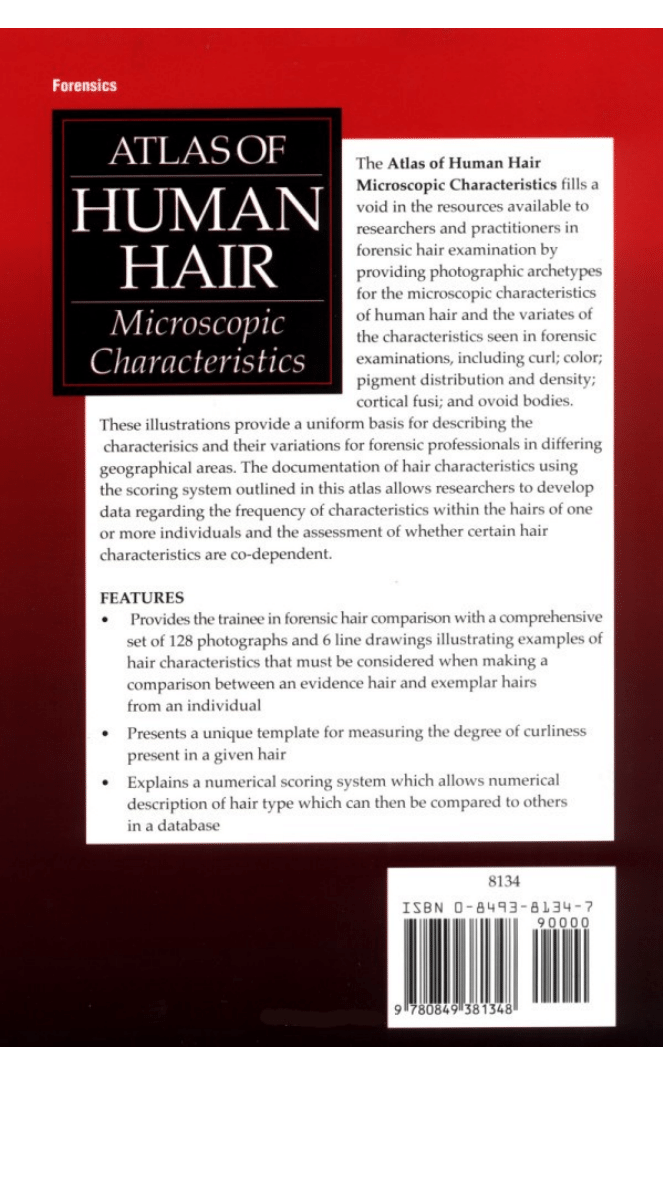
Document Outline
- Atlas of Human Hair: Microscopic Characteristics
- Preface
- Acknowledgments
- The Authors
- Table of Contents
- Chapter 1: Introduction to the Atlas of Human Hair Microscopic Characteristics
- Chapter 2: Human Hair Macroscopic Characteristics
- Chapter 3: Human Hair Microscopic Characteristics
- 3.1 Color
- 3.2 Pigment Density
- 3.3 Pigment Granule Size
- 3.4 Pigment Distribution
- 3.5 Pigment Aggregate Shape
- 3.6 Pigment Aggregate Size
- 3.7 Medulla Continuity
- 3.8 Medulla Opacity
- 3.9 Cuticle Thickness
- 3.10 Inner Cuticle Margin
- 3.11 Outer Cuticle Scale Profile
- 3.12 Cuticle Surface
- 3.13 Pigment in Cuticle
- 3.14 Cortical Texture
- 3.15 Cortical Fusi
- 3.16 Ovoid Bodies
- 3.17 Root Growth Stage
- 3.18 Distal Tip Characteristics
- 3.19 Maximum Shaft Diameter
- 3.20 Shaft Aberration
- 3.21 Hair Treatments
- 3.22 Hair Diseases and Disorders
- 3.23 Miscellaneous Characteristics
- 3.24 Insect, Arachnid, and Fungal Presence and Damage
- Chapter 4: Human Hair Cross-Section Characteristic Variates
- Chapter 5: Human Hair Microscopic Characteristics: Photographs and Drawings of Variate Archetypes and Examples
- 5.1 Color
- 5.2 Pigment Density
- 5.3 Pigment Granule Size
- 5.4 Pigment Distribution
- 5.5 Pigment Aggregate Shape
- 5.6 Pigment Aggregate Size
- 5.7 Medulla Continuity
- 5.8 Medulla Opacity
- 5.9 Cuticle Thickness
- 5.10 Inner Cuticle Margin
- 5.11 Outer Cuticle Scale Profile
- 5.12 Cuticle Surface
- 5.13 Pigment in Cuticle
- 5.14 Cortical Texture
- 5.15 Cortical Fusi
- 5.16 Ovoid Bodies
- 5.17 Root Growth Stage
- 5.18 Distal Tip Characteristics
- 5.19 Shaft Aberration
- 5.20 Hair Treatments
- 5.21 Hair Diseases and Disorders
- 5.21.1 Trichorrhexis Nodosa (see Figure 5.21.1)
- 5.21.2 Trichorrhexis Invaginata (see Figure 5.21.1)
- 5.21.3 Trichoschisis (see Figure 5.21.1)
- 5.21.4 Pili Annulati (see Figure 5.21.1)
- 5.21.5 Monilethrix (see Figure 5.21.1)
- 5.21.6 Pili Torti (see Figure 5.21.1)
- 5.21.7 Trichonodosis (see Figure 5.21.1)
- 5.21.8 Cartilage Hair Hypoplasia
- 5.22 Miscellaneous Characteristics
- 5.23 Insect, Arachnid, and Fungal Presence and Damage
- 5.24 Cross-Sectional Shape
- 5.25 Cross-Sectional Pigment Distribution
- Chapter 6: Human Hair Types
- References
- Glossary
- Bibliography
- Back Cover
- LinkToy : )~
Wyszukiwarka
Podobne podstrony:
Maslow (1943) Theory of Human Motivation
crc press cyber crime investigator 27s field guide
2002 mol genetics of human cognition MolInterv
Psychology and Cognitive Science A H Maslow A Theory of Human Motivation
Comparison of Human Language and Animal Communication
Hume A Treatise of Human Nature
THE UNIQUENESS OF HUMAN LANGUAGE ANIMAL VS
Dragons Touch Weaknesses Of Human
Berkeley A Treatise Concerning the Principles of Human Knowledge
CRC Press Access Device Fraud and Related Financial Crimes
Historia filozofii nowożytnej, 16. Berkeley - a treatise concerning the principles of human knowledg
Historia filozofii nowożytnej, 16. Berkeley - a treatise concerning the principles of human knowledg
nature of human language
GLOSSARY OF HUMAN RESOURCES TERMS
Anatomical evidence for the antiquity of human footwear use
pneumatosophy mysteries of human being
Dental DNA fingerprinting in identification of human remains
więcej podobnych podstron